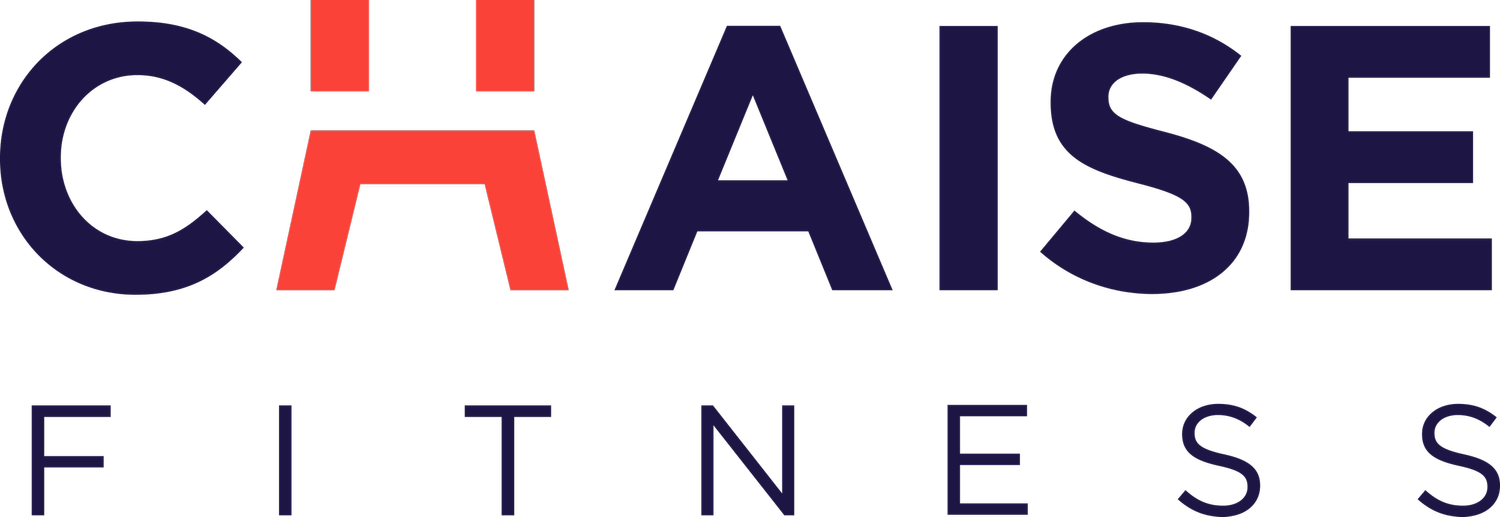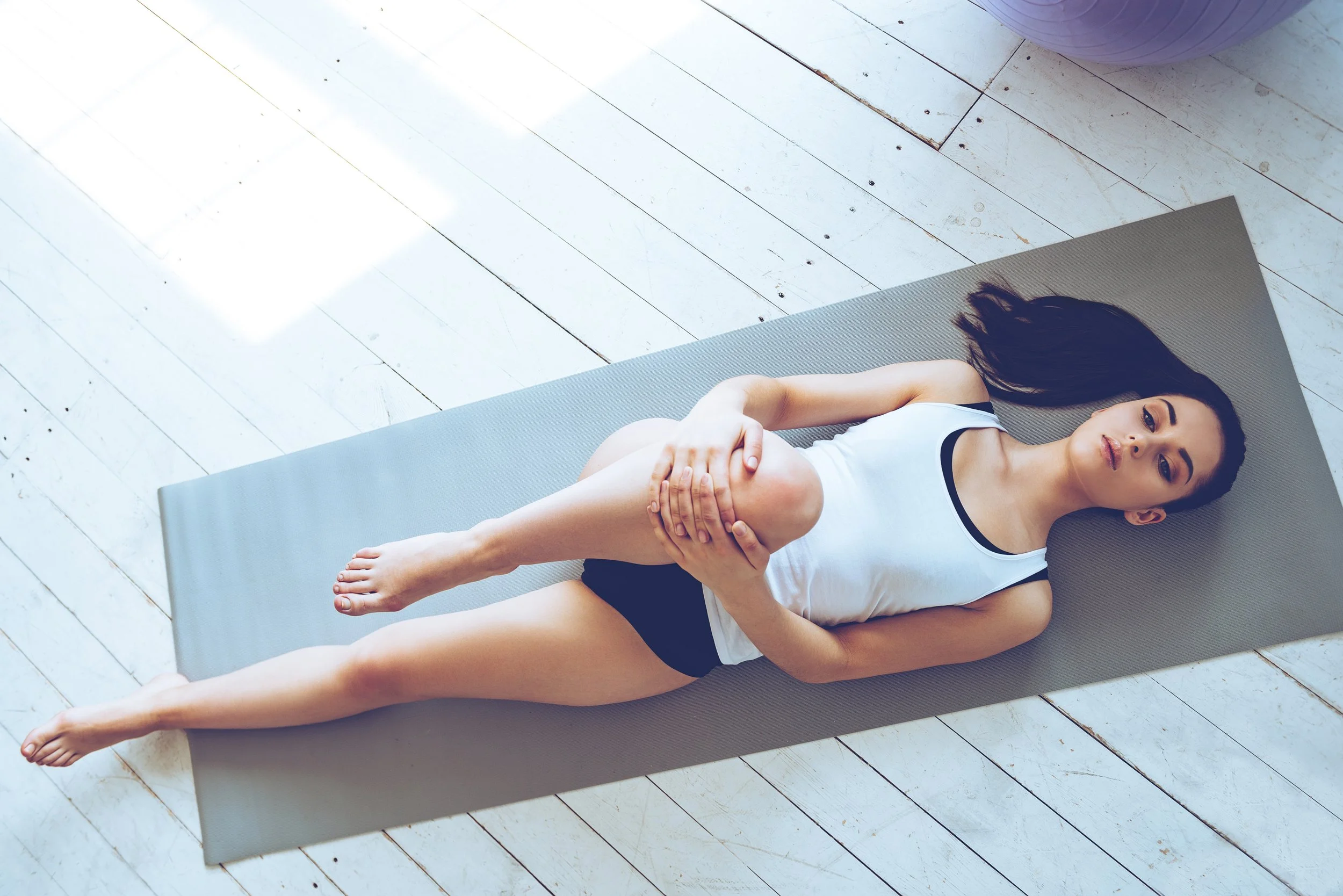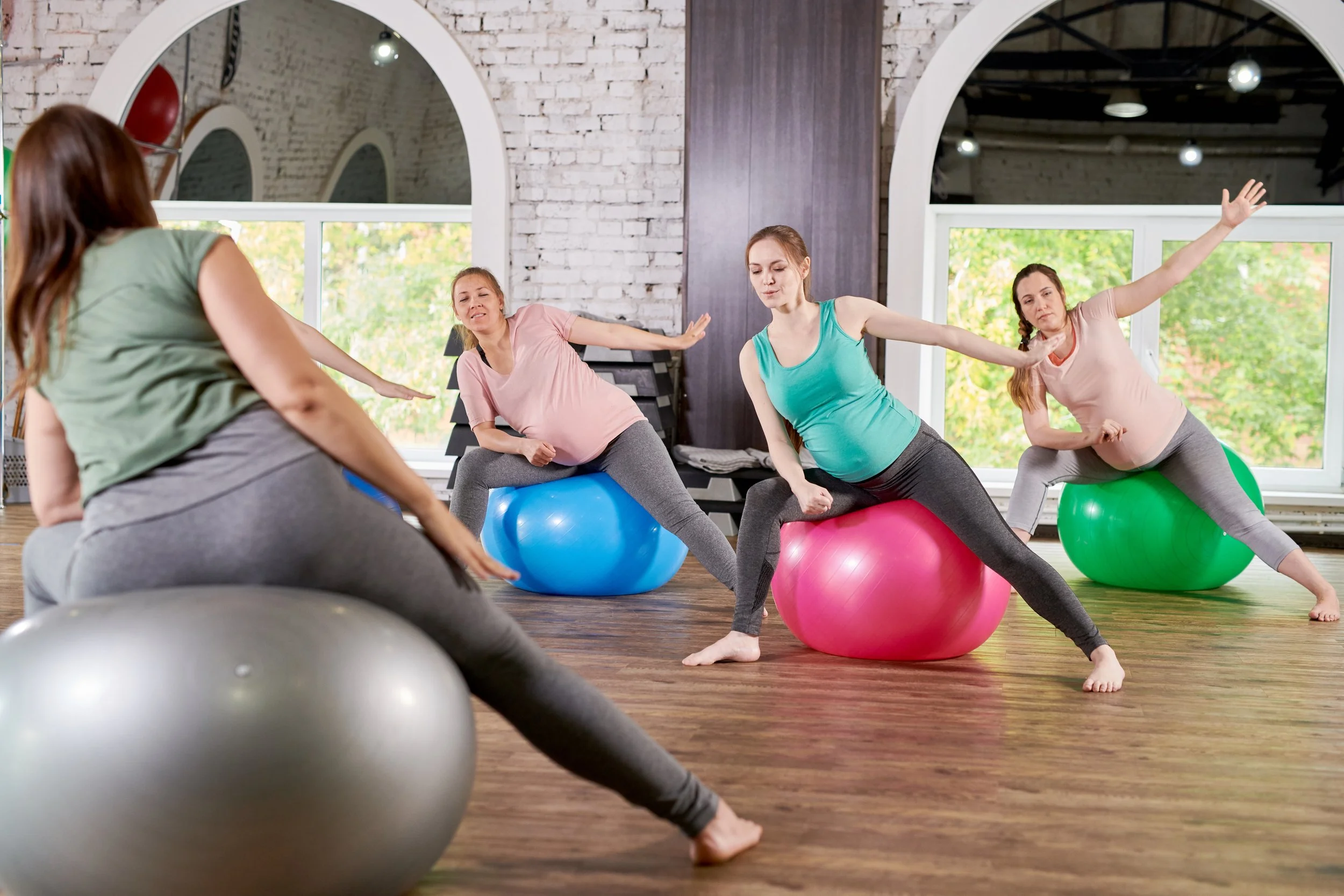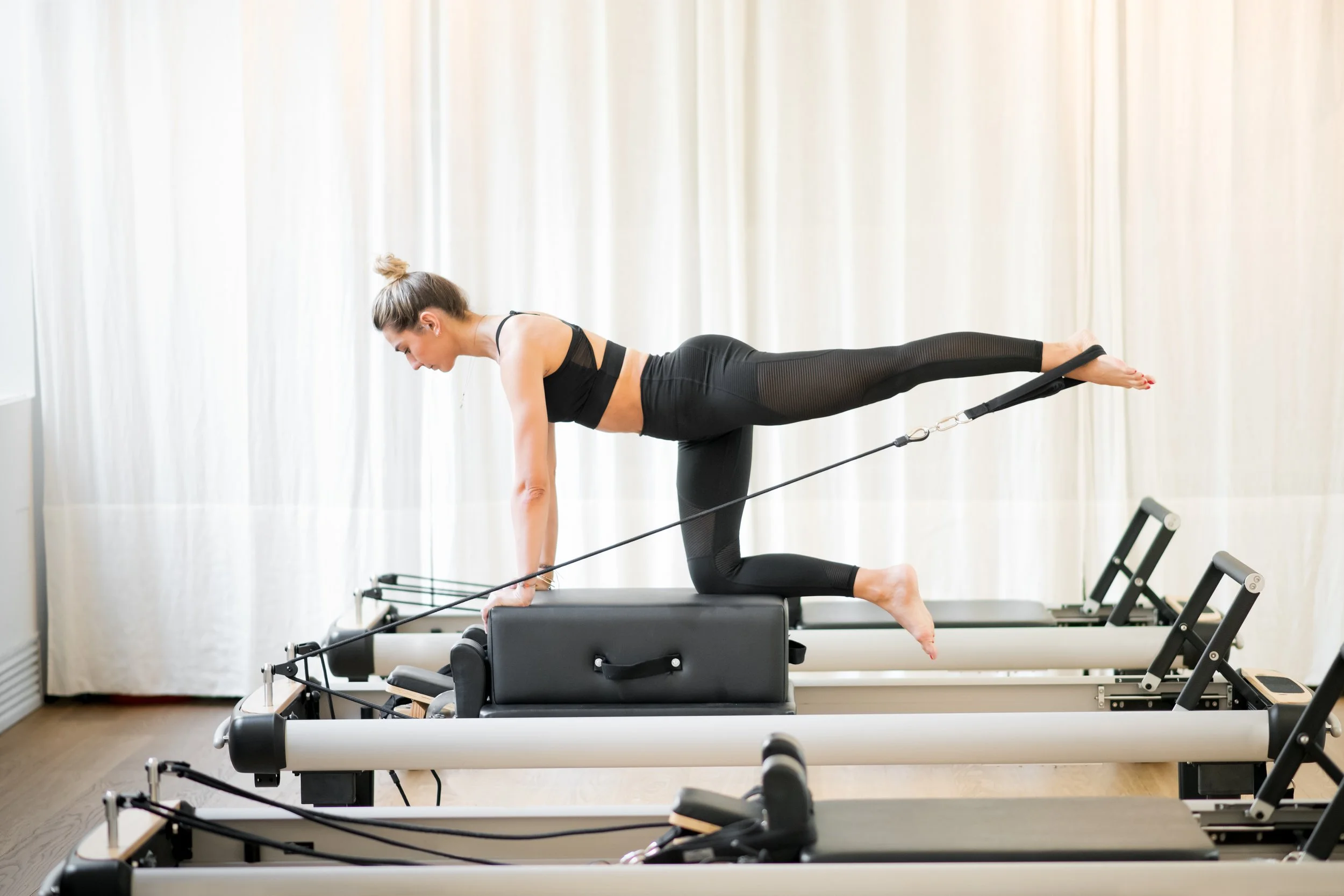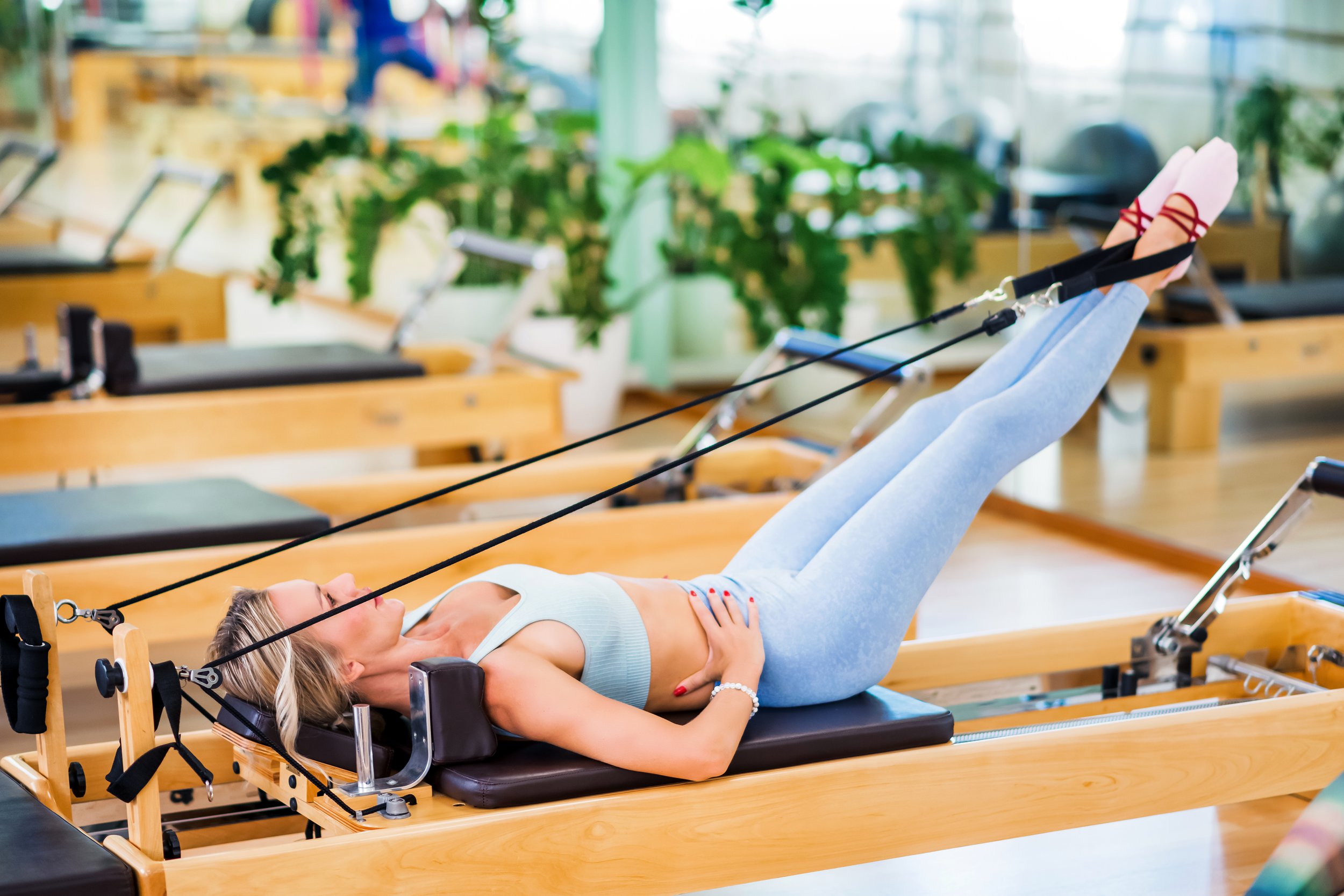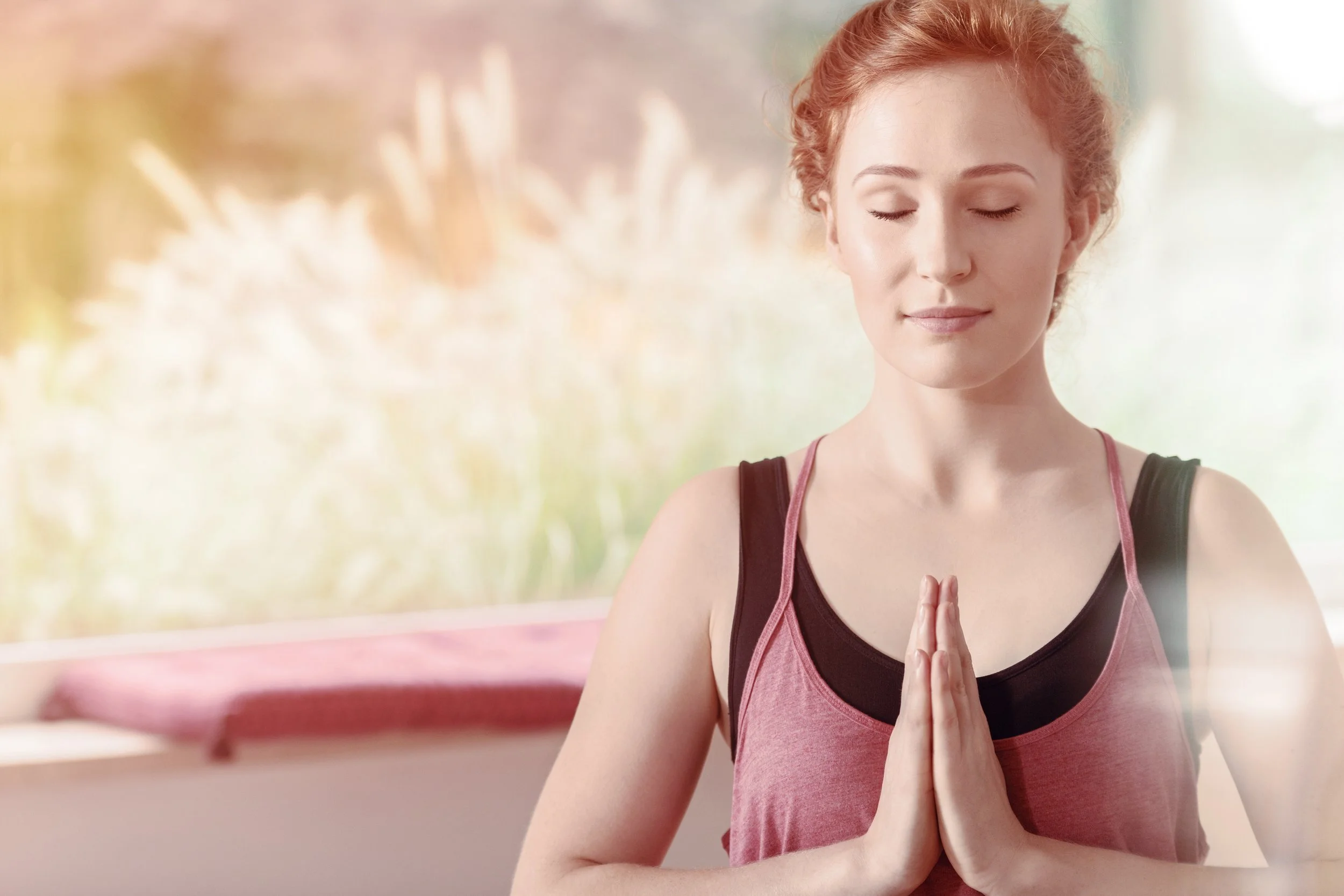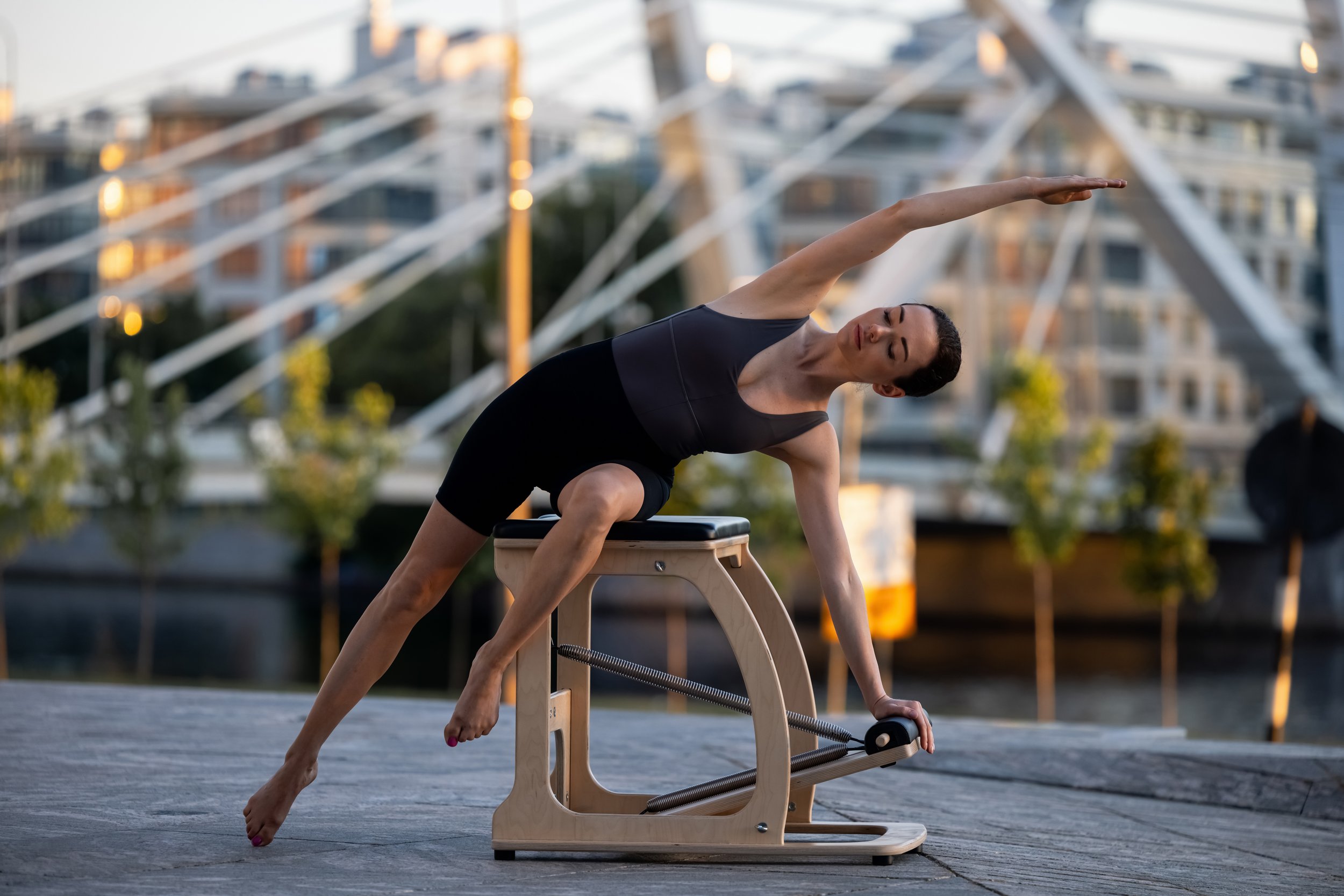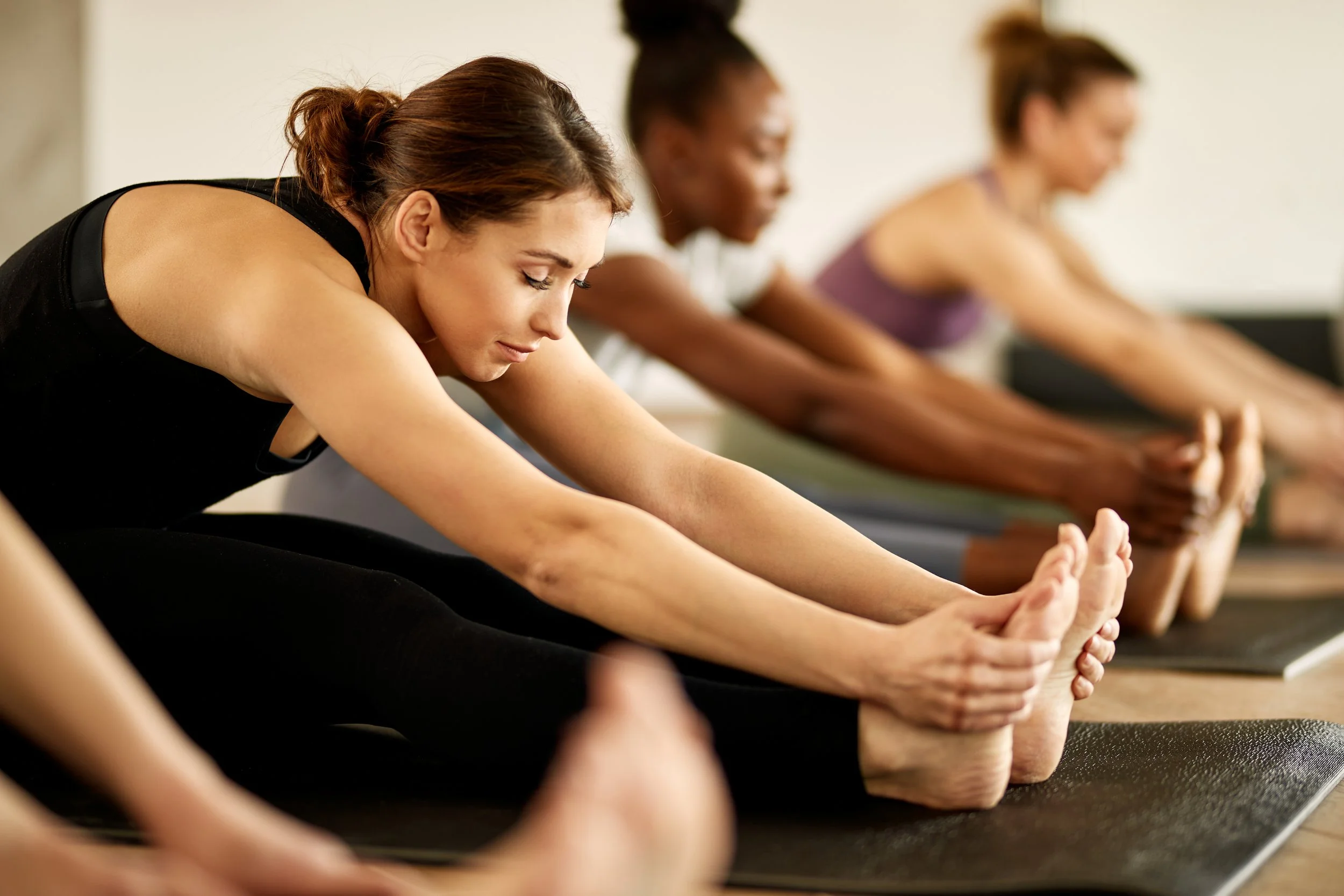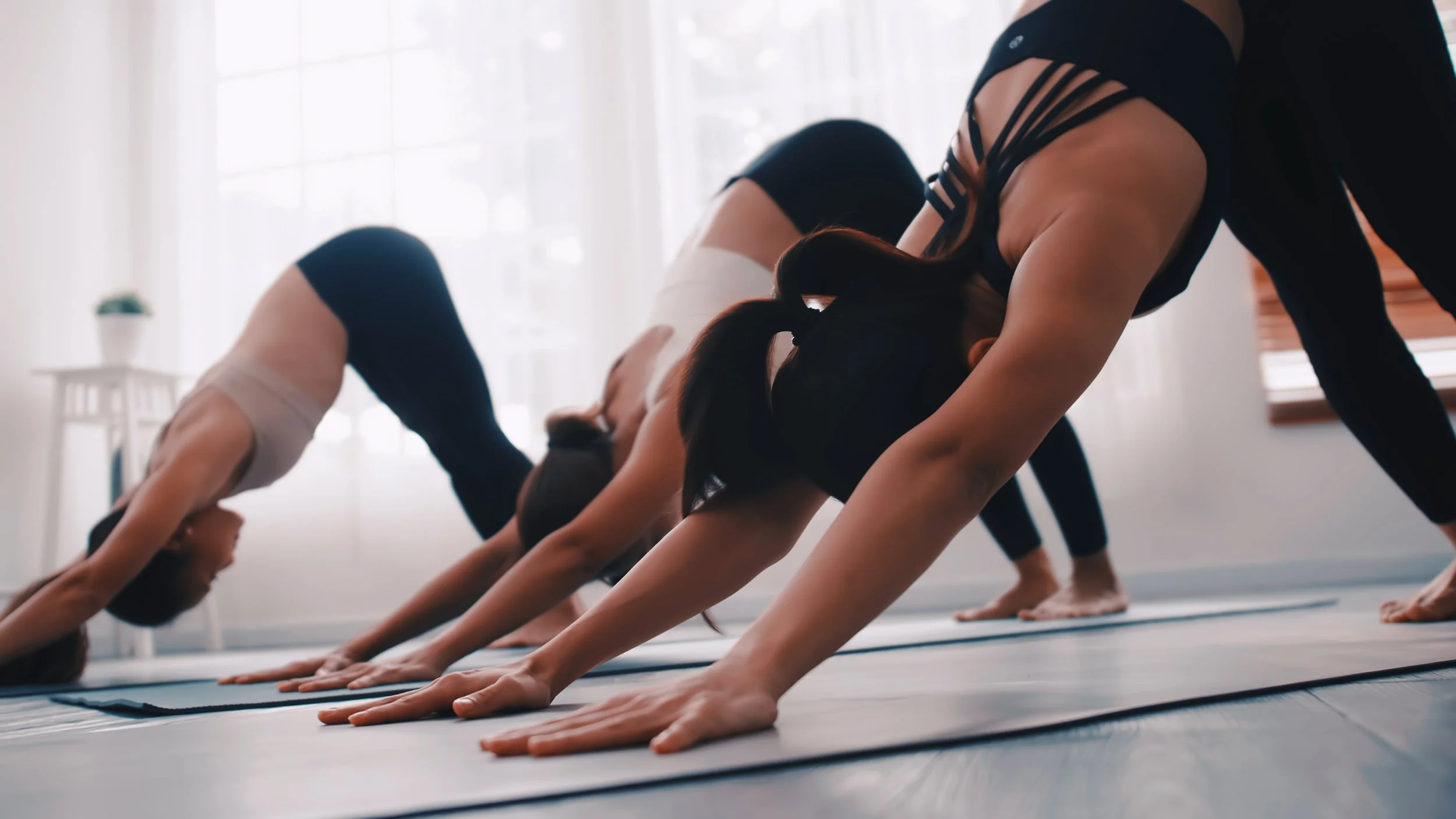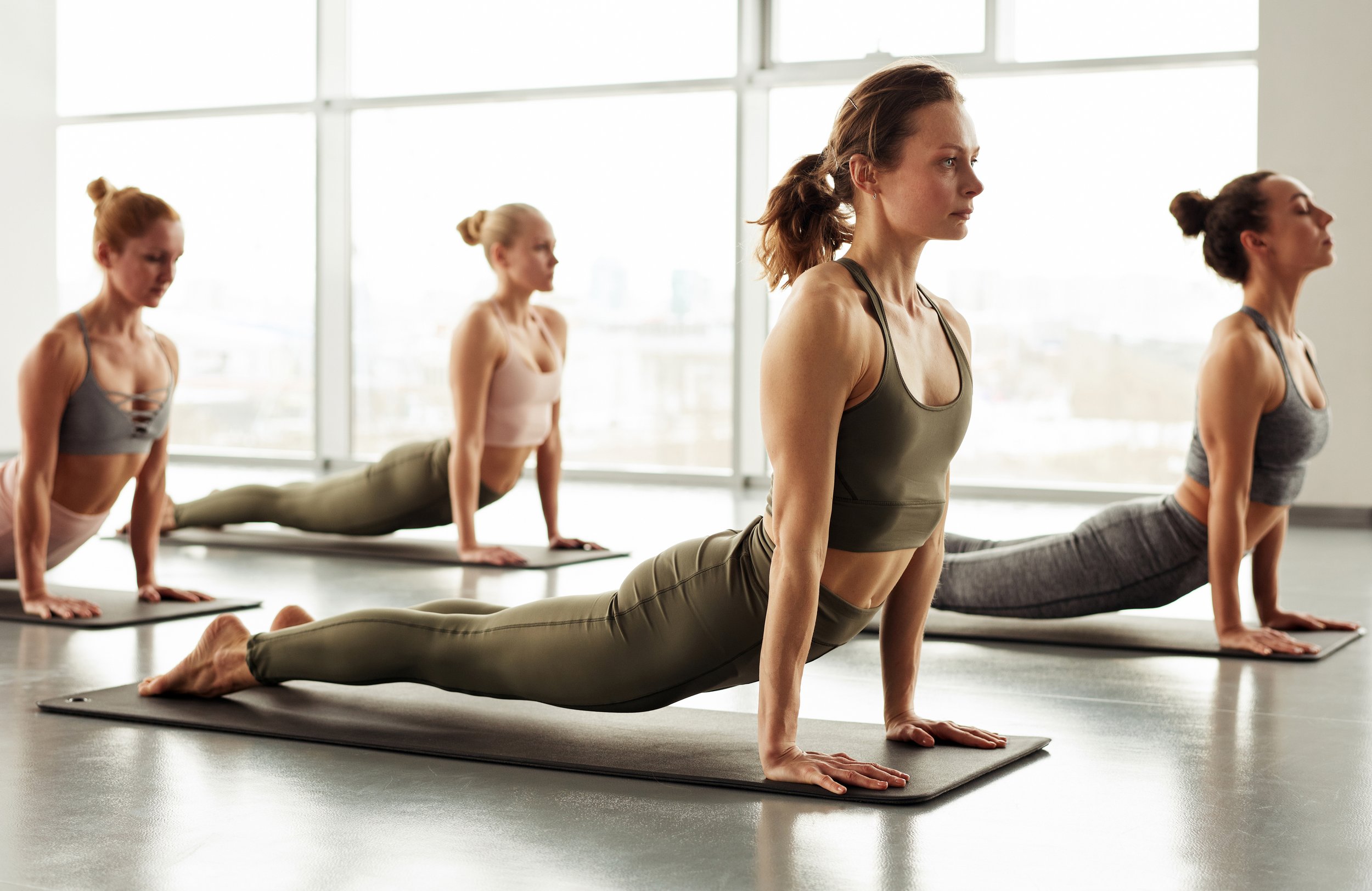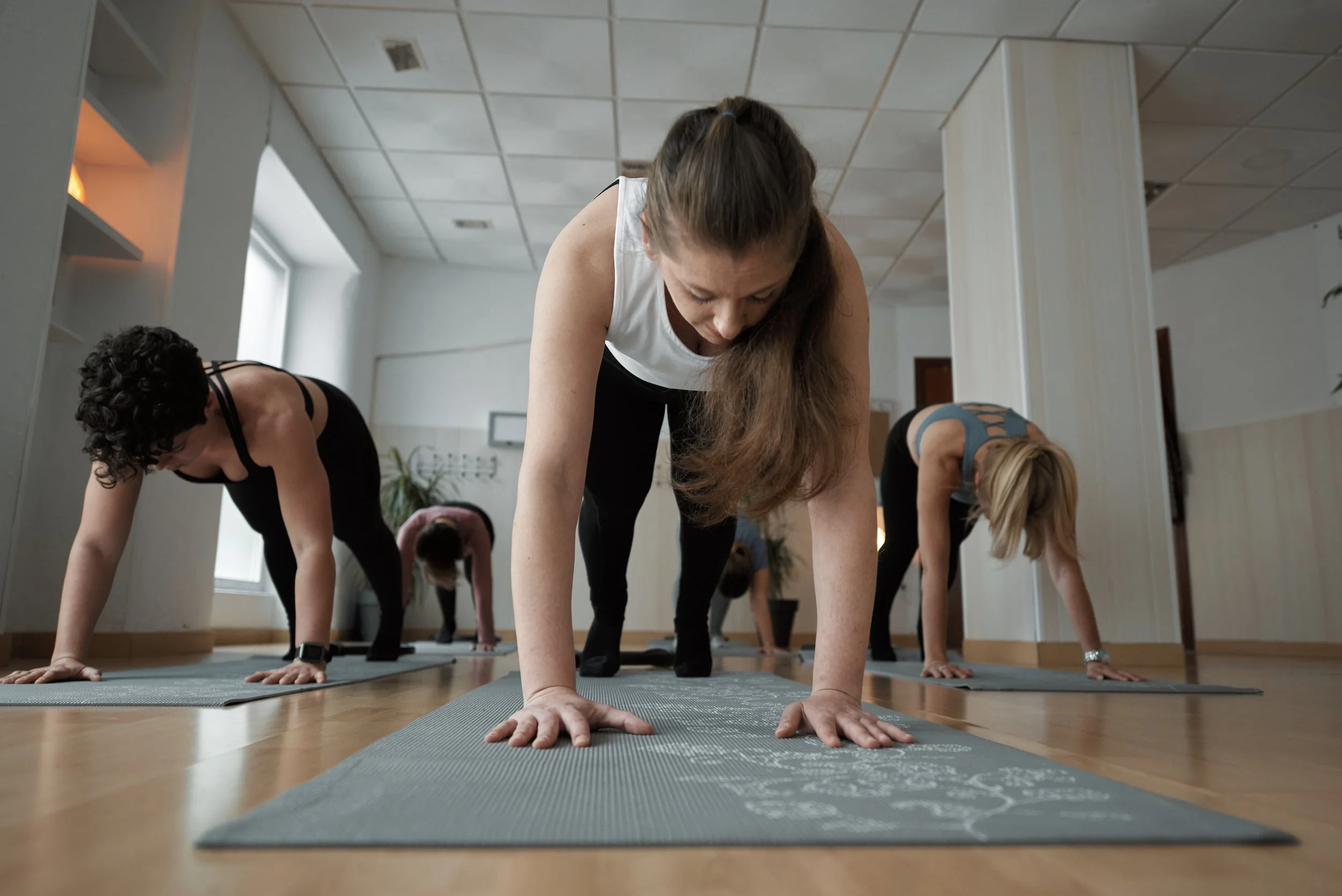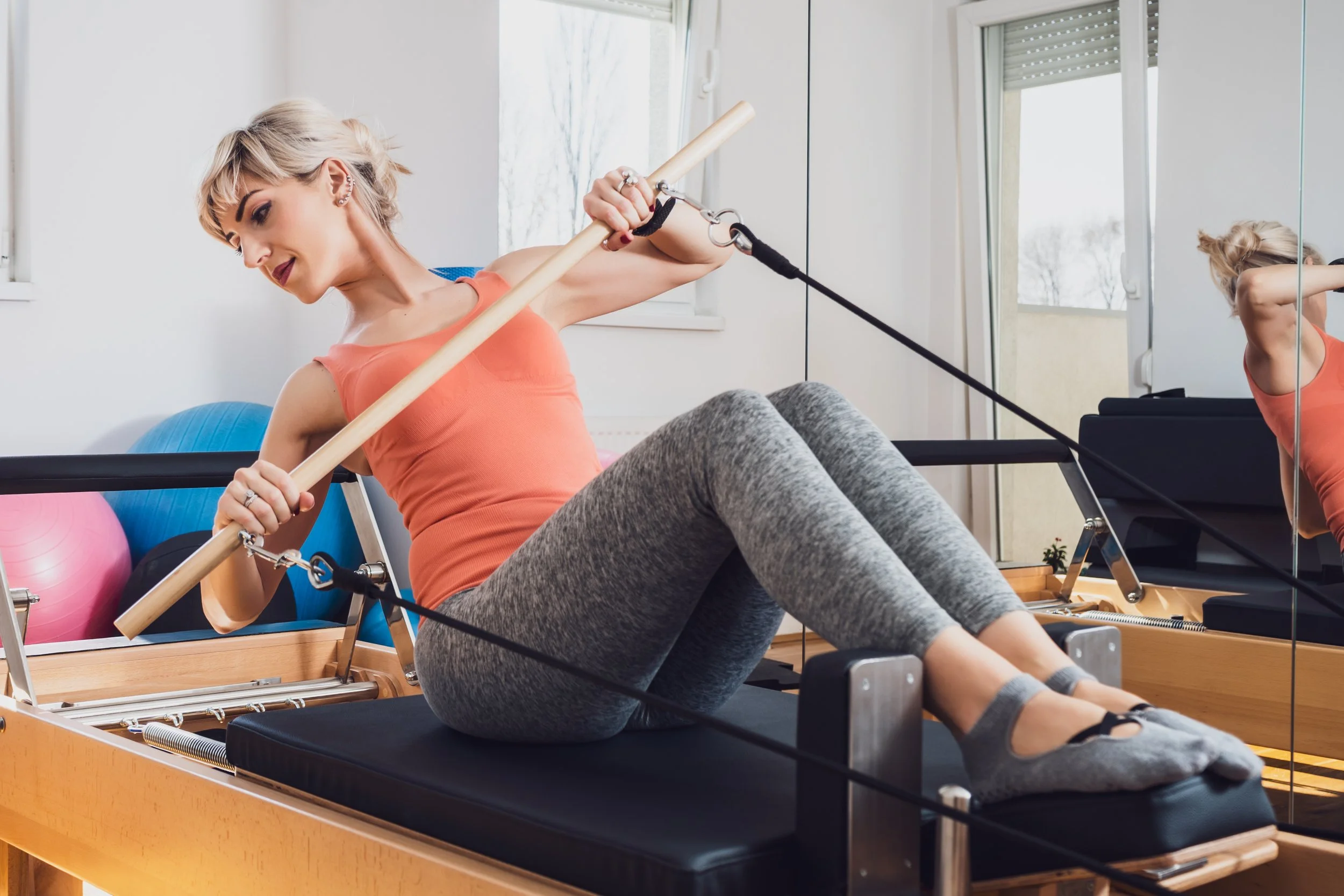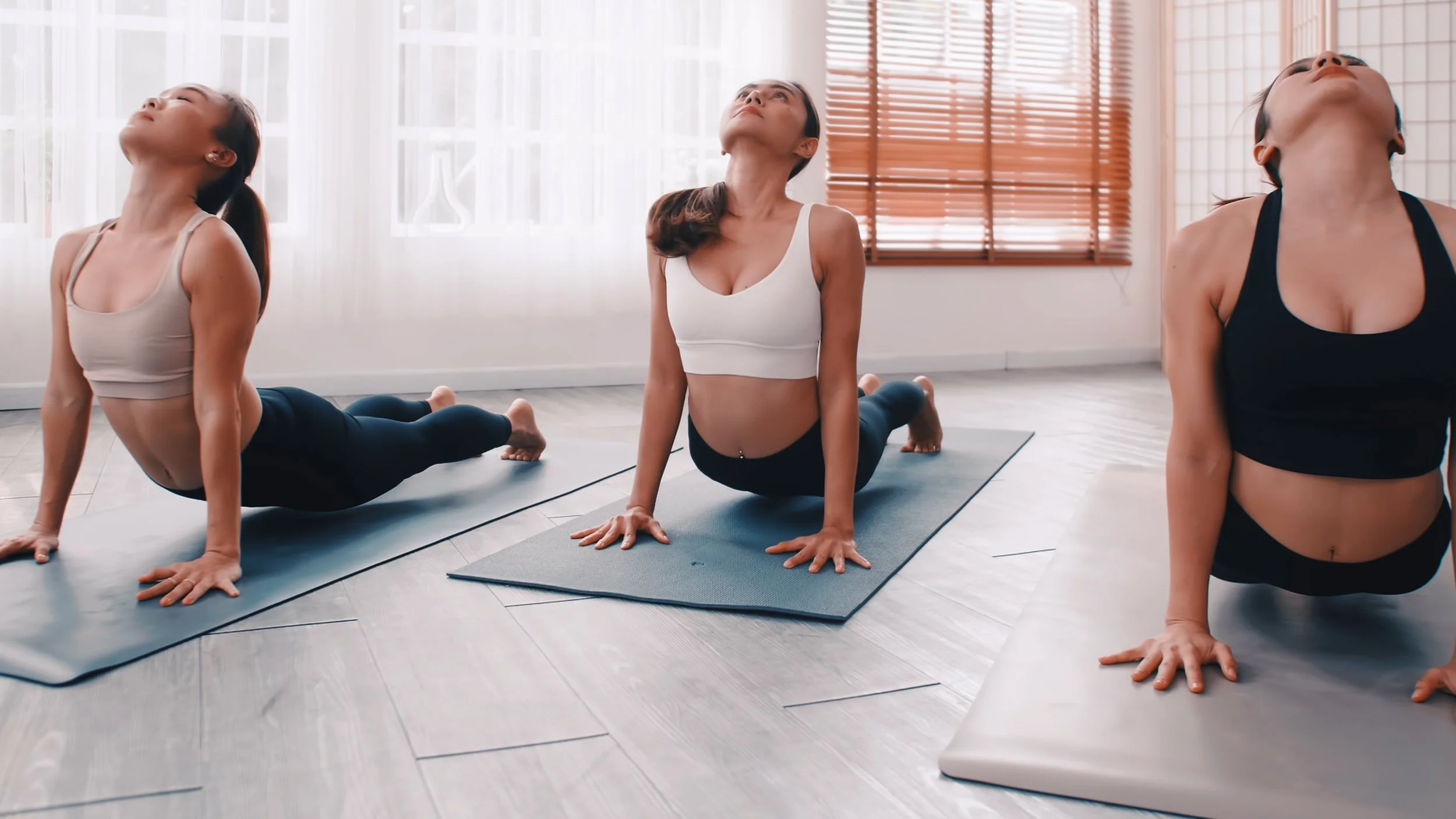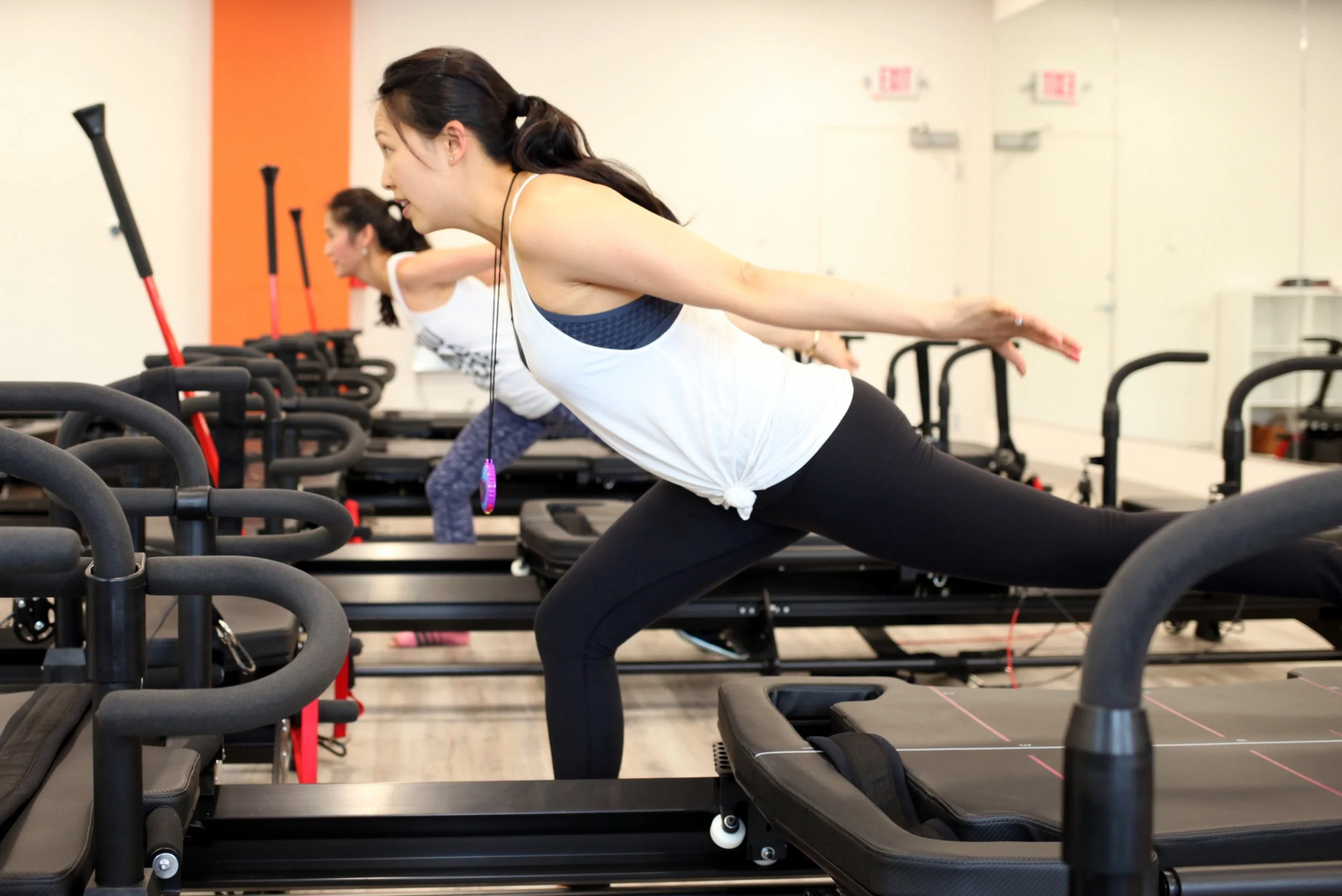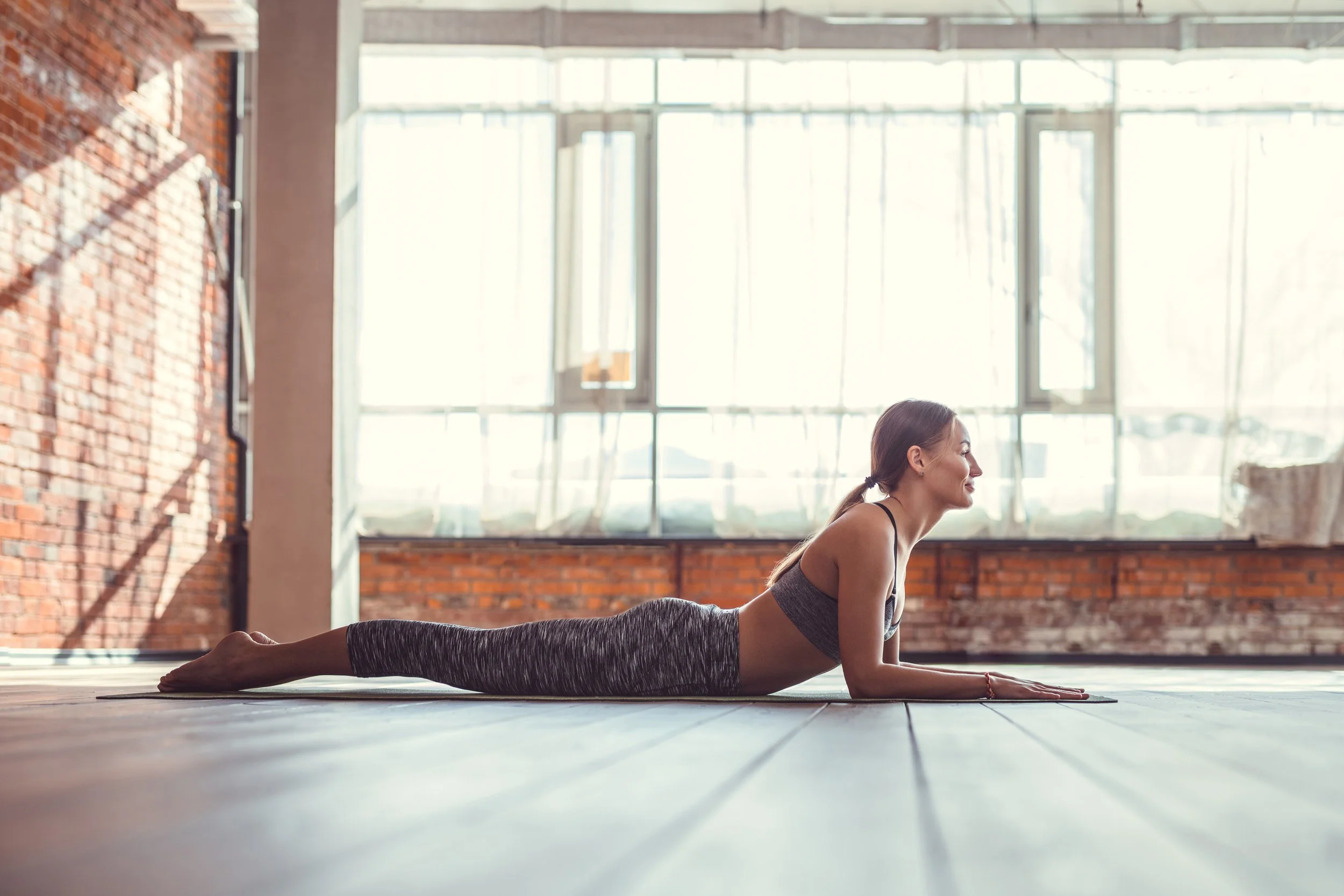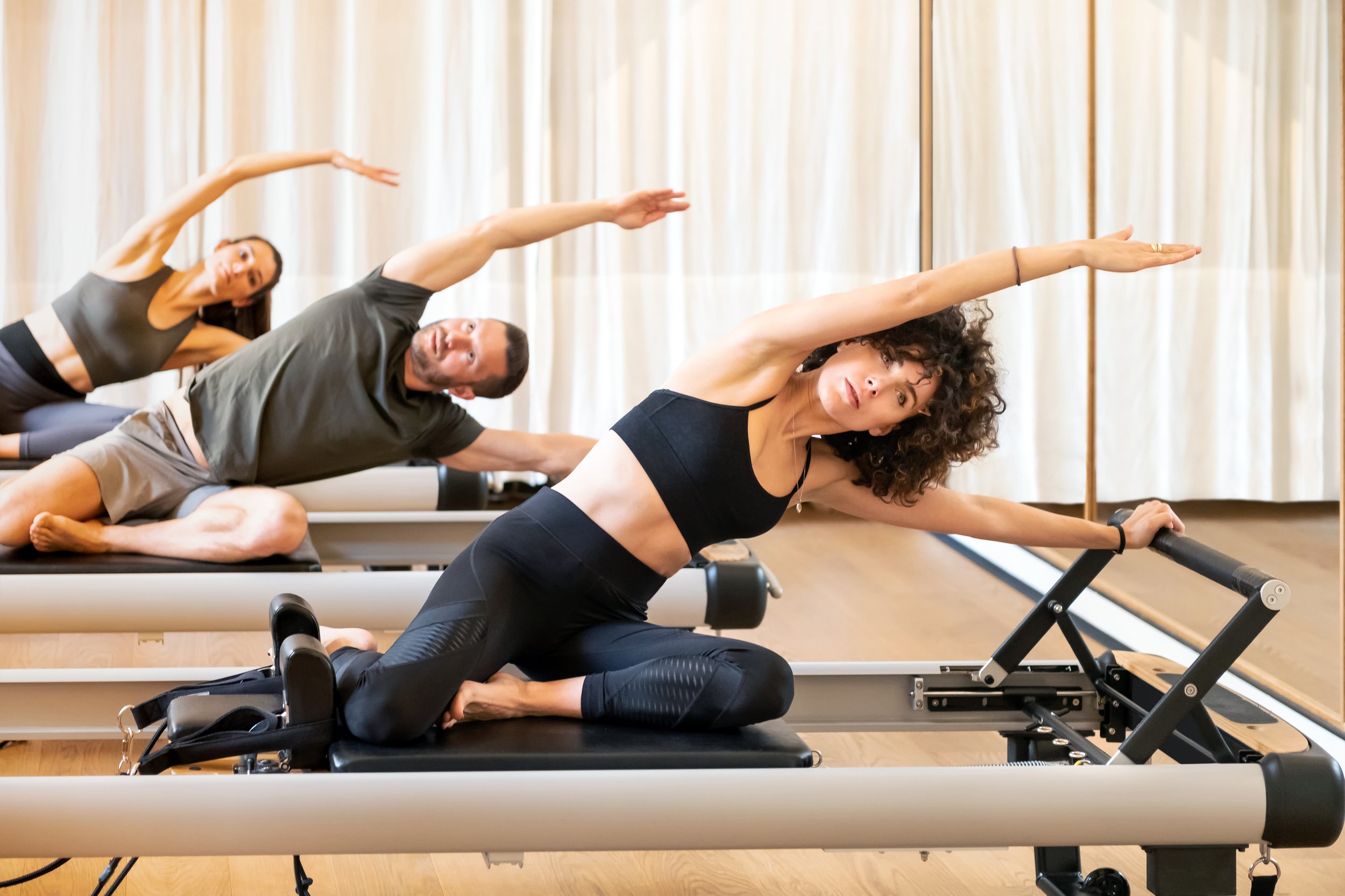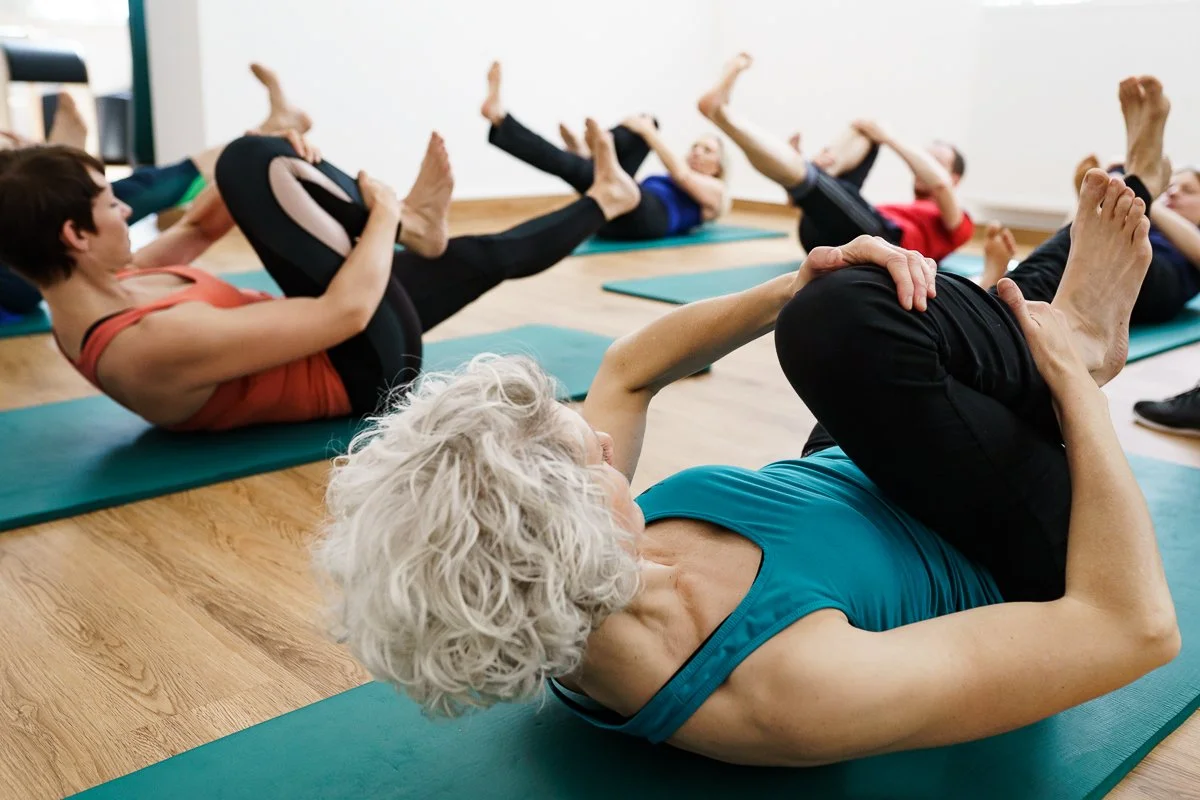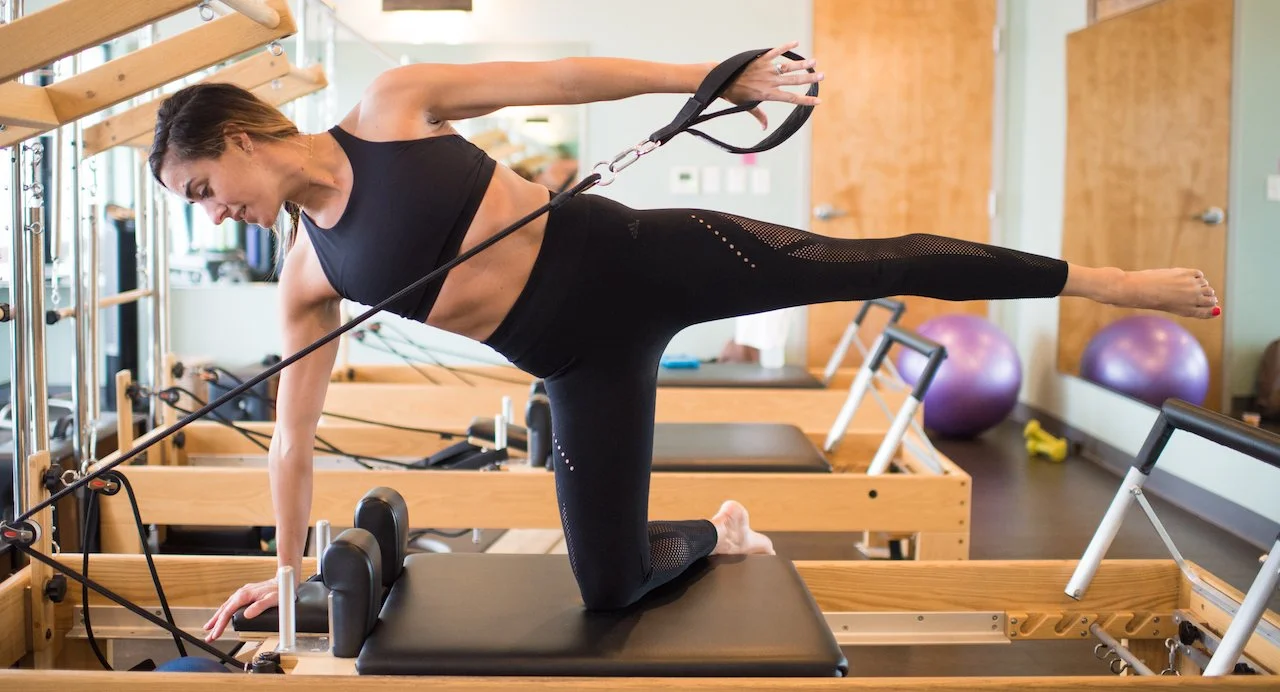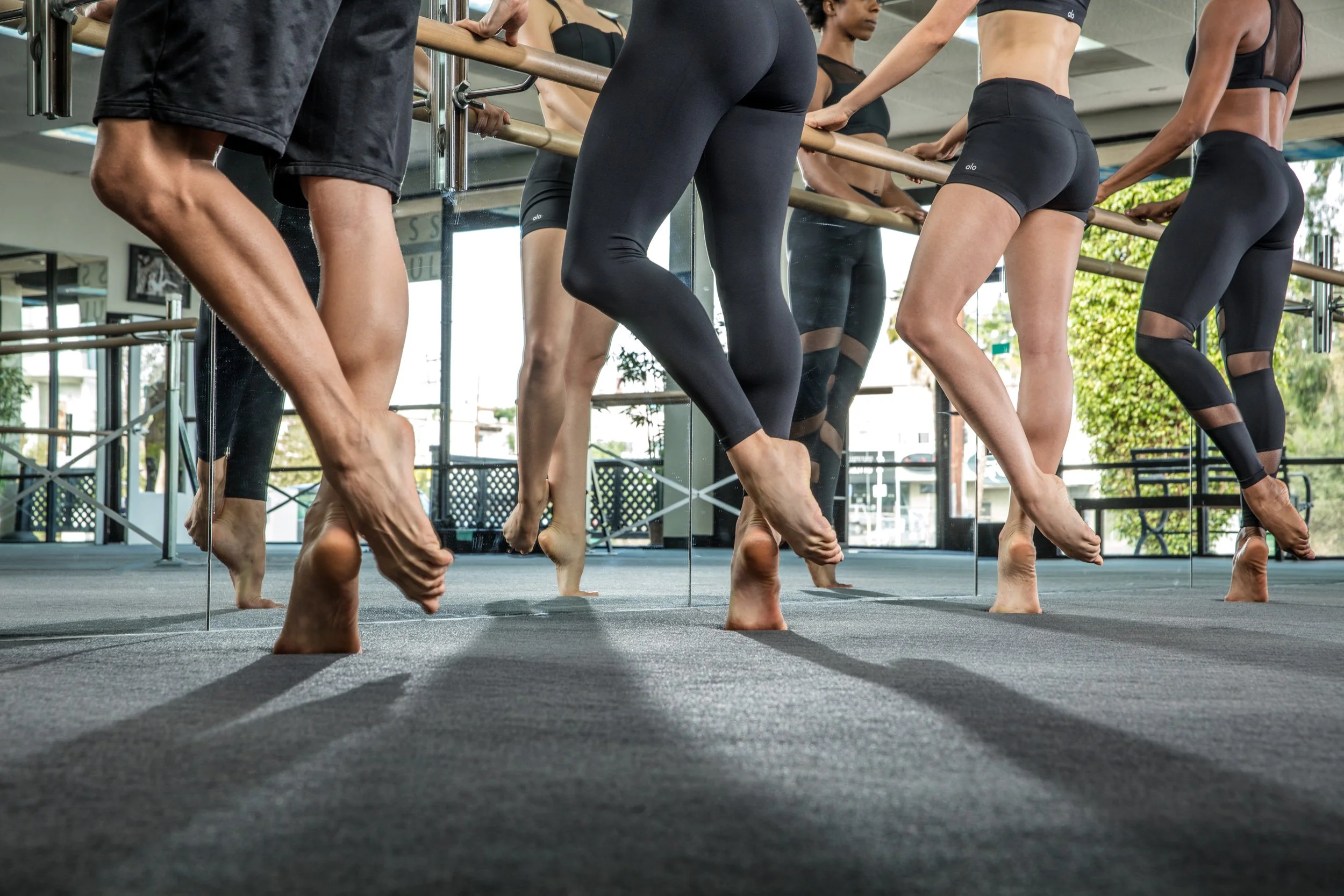Legs Tone and Trim With Pilates
Everyone has go-to muscles that they use to perform daily activities, and they vary from person to person depending on body shape and lifestyle. We often use these muscles subconsciously, which can lead to overuse injuries. These muscles are also easy to fire while working out, building bulk in the dominant muscles that are already strong and making it difficult to correct imbalances and evenly distribute the workload during exercise.
Toning Your Legs With Pilates
The beauty of private Pilates sessions is that the instructor can focus on identifying and strengthening an individual’s weak muscles. For legs specifically, dominant and weak muscles depend largely on posture and gait. Many people rely on their quads and are disconnected from their inner thighs and their medial hamstrings. Others are more disconnected from their gluteus Medius (one of three glute muscles) or the deep rotators of their hips.
Legs
To learn how to work the entire leg and achieve the desirable long, lean aesthetic Pilates are the answer. Traditional exercises only allow people to rely on their dominant muscles. Pilates requires grace, balance, flow, and control, which targets all of the muscles in the leg, including small intrinsic musculature and weak muscle groups. The concept keeps legs long and slim as they’re being toned.
Leg workouts without weight are a great place to start if you haven’t exercised for a while. Your legs have huge and powerful muscles which move you around all day. This means they are naturally stronger than your arms! The best part about training legs is you can do it at home without any weights at all! This makes it really accessible and if you are worried about not knowing what you are doing, you can do it in your own time and at your own speed!
Pilates for legs – 8 effective Pilates leg exercises you can do at home!
Sumo squat with calf raises.
Squat to calf raise.
Single leg bridge.
Lateral lunge transfers. Leg workouts without weights.
Single leg bridge with rotation.
Reverse Nordics and prep.
Single leg calf raises.
ChaiseFitness is Among the Best Pilates Studios in Manhattan
At ChaiseFitness, we believe that anyone can be fit—no matter what skill level or body type. This belief inspired the creation of our patented Reinvention Method, which is for everyone—the athlete, the dancer, the beginner, the advanced, the rebuilder. We blend Pilates, ballet, and strength training and equip you with a chair and overhead bungees so that you work out all your muscles every time. We are located in the Upper East Side in Manhattan. For more information, you can contact us at (973)996-2063, or visit our website.
Arms Tone and Trim
If you want to lose fat from your arms, you must do these Pilates exercises that specifically target the fat around the arms. Women often forget to exercise their shoulders when it comes to workouts unlike men who are equally concerned about their shoulders as they are for their abdomen. Your hands and legs are the most exercised parts of the body and therefore, they should be strong and toned both. Do not ignore the fat hanging from your arms. Tone thy arms with simple yet effective Pilates exercises.
Pilates for Toning the Arms
Arms tone and trim
Pilates is a great exercise to strengthen the core but when talking about arms, it works on the endurance of the muscles which means the movements are done one after another and in a smooth manner. This means it works on all of those small muscles and muscles groups. This, in turn, gives you a shaped, toned and lean look.
Posterior Standing Hundred
Stand in the straight position with your toes shoulder-width apart.
Now clap with your arms quickly back and forth
Pushing back, focusing on pushing away and behind the body.
This exercise targets the triceps area and back of the arms.
Pilates doesn’t use weights, it just uses a progressive resistance like a string, or we will do exercises with an elastic band. If someone doesn’t have a band, all of the exercises can be done with a can of soup or a water bottle. This can provide resistance.
Bra Fat
Exercises need to be done one after the other in a smooth manner without any breaks in between. When they have combined altogether, they actually work on all the muscle groups. The posterior part of the arms which is called the bra fat is difficult to reach. Since this area is very difficult to reach through the conventional exercises like bicep curls, Pilates works for bra fat area very well. In short, Pilates not only tone the front of the arms but also the back part of the arms, shoulder blades and bra fat.
Best Exercises to Get Rid of Bra Fat
Push-ups. It helps in strengthening of back muscles
Plank with dumbbell. This exercise helps in the toning of the core muscles, and stabilizes the back
Dumbbell bent-over row
T-Raises
Plank with lateral arm raise
Upright rows
Looking for an Excellent Pilates Studio in the Upper East Side Area?
At ChaiseFitness, we believe that anyone can be fit—no matter what skill level or body type. This belief inspired the creation of our patented Reinvention Method, which is for everyone—the athlete, the dancer, the beginner, the advanced, the rebuilder. We blend Pilates, ballet, and strength training and equip you with a chair and overhead bungees so that you work out all your muscles every time. We are located in the Upper East Side in Manhattan. For more information, you can contact us at (973)996-2063, or visit our website.
Is 20 Minutes of Pilates A Day Enough?
Is 20 minutes of Pilates a day enough of a workout to see results? For most individuals, sticking to 20 minutes for a Pilates session is enough. So, 20 minutes / 3 times a week is a good schedule. You may find that as you get more comfortable with the routines and you begin to get stronger and more flexible that you will want to increase this to 30 minutes or more.
Is 20 Minutes of Pilates A Day Enough?
This is an individual’s choice, and you can certainly discuss this with your Pilates instructor.
Can You Lose Weight by Doing Pilates?
Like any exercise program performing Pilates will help you to burn calories. So, as long as you consume less calories than you burn, Pilates will help you to lose weight.
The great benefit of Pilates is that it’s a whole-body workout. You get cardio, strength training, stretching and toning. At Chaise Fitness, we believe that it’s one of the best exercise programs that can be performed by almost everyone at any age and at any stage of physical fitness.
Private Pilates Sessions (55 minutes)
If you are new to Pilates, we recommend at least a few private sessions (one-on-one) with one of our trained Pilates instructors. This will get you more comfortable with the routine that will work for your specific goals and your specific body.
Semi-Private Pilates Sessions (55 minutes)
In our semi-private sessions – one of our instructors will work with you and one other client. Sharing the experience of the exercises with another person can help to motivate you through the routine and you may just make yourself another friend!
Trio Pilates Sessions (55 minutes)
In our sessions – one of our instructors will work with you and two other clients throughout the session. This is a great way to share the cost of a Pilates session and to work with others for motivation and inspiration.
Is 20 Minutes of Pilates A Day Enough?
Each session is tailored to the specific needs and goals of the client. Our diverse Pilates instructors can focus on toning particular areas of the body, rehabilitating an injury, bringing relaxation and strength to the body, or activity-specific training such as dance, martial arts, or a particular sport toning.
Check Out ChaiseFitness Today!
At ChaiseFitness, we believe that anyone can be fit—no matter what skill level or body type. This belief inspired the creation of our patented Reinvention Method, which is for everyone—the athlete, the dancer, the beginner, the advanced, the rebuilder. We blend Pilates, ballet, and strength training and equip you with a chair and overhead bungees so that you work out all your muscles every time. We are located in the Upper East Side in Manhattan. For more information, you can contact us at (973)996-2063, or visit our website.
Pilates During Pregnancy
If you are pregnant, and want to do some exercise, but not sure what exercises are safe to do, try pregnancy pilates! Not only is it safe to do during pregnancy, but it can actually help your body to accommodate the pregnancy better, to assist with delivery, and to recover better and regain your shape after the baby is born. This form of exercise is highly recommended by many mothers, and pregnant moms often experience a wide range of benefits that stretch beyond the mere physical.
7 Ways that Pilates Benefits Pregnant Moms
1. Core muscles
Our abdominal and back muscles support our spinal column, our pelvic area and the spine, and they tend to become increasingly taxed during pregnancy, as the baby grows heavier and bigger. This often results in back pain, as the abdominals are not strong enough to adequately support the back and the back muscles are weakened by the growing belly, which causes the lower back to arch inwards, as the load gets heavier. Doing regular Pilates will strengthen these muscles and provide better support for the back and the overall skeletal structure during pregnancy.
2. Pelvic floor
These muscles are vital to having a healthy pregnancy and birth – they help to contain and hold everything in place in the lower abdomen. When the pelvic floor is healthy, it is able to contract and release on demand, and the perfect exercise to strengthen this group of muscles is Pilates. Strong pelvic floor muscles are also required for after the pregnancy, to help everything fall back into shape.
3. Posture
The weight of the baby often pulls one forward, and this results in incorrect posture and discomfort. Doing the correct exercises helps to correct postural mistakes and helps to hold the shoulders back in a healthier position.
4. Circulation
While strong muscles are very necessary, it is also vital to have a healthy circulation. The volume of blood increases to up to forty percent during pregnancy, and a strong circulation is needed to pump oxygen-filled blood to all the parts that are needed for the baby to grow and for mom to stay healthy.
5. Breathing
Learning good breathing techniques helps with relaxation and calms the mind during periods of stress. Pilates focuses heavily on breathing techniques that will sustain the mother not only through the stressful times of pregnancy, but also after the birth, and helps to keep the mind relaxed when needed most. Breathing techniques taught by BASI Pilates in Pretoria also helps to control breathing when in labour.
6. Feet
The extra weight of the baby places huge stress on the feet, and often feet become flatter or the arches fall as a result. Pilates helps to build healthy feet and thereby prevent a lot of common foot problems during and after pregnancy.
7. Control
Our techniques provide pregnant women with a sense of control over their bodies, during a time when it feels like everything is out of control. It also provides a sense of wellbeing and accomplishment, both of which may lead to more self-confidence. Getting the body back into shape after pregnancy is also easier, which also gives the self-esteem a boost!
Check Out ChaiseFitness for Pilates Classes in Manhattan
At ChaiseFitness, we believe that anyone can be fit—no matter what skill level or body type. This belief inspired the creation of our patented Reinvention Method, which is for everyone—the athlete, the dancer, the beginner, the advanced, the rebuilder. We blend Pilates, ballet, and strength training and equip you with a chair and overhead bungees so that you work out all your muscles every time. We are located in the Upper East Side in Manhattan. For more information, you can contact us at (973)996-2063, or visit our website.
PILATES FOR STRESS?
We often hear about stress everywhere; in the news, at the doctor’s office, waiting in line, or just among family and friends. We’ve learned over the past couple of decades that excessive stress has long term detrimental effects. Of course, some stress in life is okay and even needed to accomplish goals and move forward, but we’re talking about the kind of stress that keeps you in ‘fight or flight’ mode and plays havoc on your nervous system.
Stress can stem from many sources - work, finances, sick loved ones, or certain times of the year where life is extremely hectic, like holidays and big events.
But what effect can stress have on your overall health?
For starters, a decrease of the immune system. Have you noticed how a person who is swamped at work or generally dissatisfied tends to be sick frequently? Stress can be a trigger or factor for disease, it can affect the digestive system and mood, and it has negative effects on learning and mental health.
Enter Pilates. The widely known benefits of Pilates include a strong core, improved posture, increased flexibility, and a toned body. Pilates is that and so much more.
The essence of Pilates is its mind-body connection, incorporating principles such as breathing, concentration, flow, and precision. Pilates has the magic element of exercise and movement that gets those feel-good endorphins released in the body along with its focus on breathing, which calms the nervous system and lowers the hormone cortisol. Cortisol on its own is not a bad thing. Like everything in life, it’s all about moderation! However, for many people nowadays, life means constant stress and thus an overload of cortisol in the body. That basically translates to being on edge ALL the time. Sleep quality, diet, blood sugar balance, and inflammation are all negatively affected.
Stress management is the key and one of it’s best strategies is Pilates.
Pilates for Relaxation
As a mind-body exercise modality, Pilates bridges strengthen with stretching. This provides a relaxed but energized session reducing muscular tension and calming the mind and body. Pilates exercises are steeped in its principle of breathing. Focused breathing is known for its calming effect, both on the mind and body. Pilates can be thought of as an active meditation, especially for those that find it challenging to sit still and only breathe.
Pilates for Stress and Anxiety
With all of the distractions, responsibilities, and commitments most of us face, it can be extremely overwhelming - and in many cases unproductive - which keeps us stuck in a loop of overwhelm. Pilates focuses your attention on the practice in each moment and exercise, freeing you from thinking about anything but the practice.
Much like our smartphones that need recharging to work efficiently, so do we! Finishing your practice helps to give you a fresh and more grounded outlook.
From a physical standpoint, Pilates targets muscular strength for optimal posture and provides the foundation for a strong and connected body. That contributes to a perception of self-awareness and inner strength that can alleviate and combat feelings of anxiety.
Pilates for Mental Health
According to the WHO (World Health Organization) 25% of the world will be affected by mental and neurological disorders within their lifetime with depression and anxiety ranking the highest. Some symptoms experienced with mental illness include exhaustion, poor concentration, chest and back pain, and sleeping disorders.
Pilates can greatly benefit mental health and alleviate some of those common symptoms. Exercise, in general, is mood-elevating due to the release of those ‘feel-good’ endorphins, however, Pilates goes a step further due to its mind-body component.
The focus involved in Pilates takes the individual out of their ‘head’ and into their body. This invokes a sense of control over their body that can be transferred into their daily lives with a renewed sense of confidence. Breathing with movements heightens mental clarity and mindfulness, again taking them away from any problems or worries.
Taking a class can build a routine as well as a social aspect of being around others.
Pilates is the ultimate act of self-care and stress management! Self-care and self-love are thrown around in media circles and even used as a marketing tool for stress management. But what are self-care and self-love? Is it treating yourself to a favorite food? Going out to a party with friends? Or waiting until you’re exhausted and deciding to go to a spa?
All of these options are fantastic and fun but like all successful aspects of life, consistency is the key. Sometimes self-care is saying no to that activity or food that is only a short term fix and will backfire later. A Pilates practice is your best short and long term solution. Ideally, you should aim for 2-3 times per week but anything consistent helps. Though it’s easy to fall into the trap of procrastinating on doing what is good for us for the sake of a project, feeling too tired, or feeling like you can’t step away, just getting yourself to that Mat will be worth all of the benefits!
Looking for an Excellent Pilates Studio in the Upper East Side Area?
At ChaiseFitness, we believe that anyone can be fit—no matter what skill level or body type. This belief inspired the creation of our patented Reinvention Method, which is for everyone—the athlete, the dancer, the beginner, the advanced, the rebuilder. We blend Pilates, ballet, and strength training and equip you with a chair and overhead bungees so that you work out all your muscles every time. We are located in the Upper East Side in Manhattan. For more information, you can contact us at (973)996-2063, or visit our website.
REFORMER PILATES FOR STRENGTH?
Reformer Pilates may be a low-impact exercise, but it is definitely a form of strength-training exercise. You may not be building up a huge sweat in the way you would with circuit training, but you will be building up your strength and gaining increased muscular endurance.
What it won’t do is grow muscle mass as dramatically as bodybuilding does. Having said that, even if you do want a body like Jason Momoa’s, Reformer Pilates can still be useful as an additional exercise as it will help you increase flexibility and resilience. Not only that, it will also build up strength in all your muscles, not just the ones you’re trying to bulk up.
How is Reformer Pilates strength training?
The way you strengthen your muscles with Reformer Pilates is to use the resistance offered by the springs and to gradually increase that resistance as your muscle mass improves. By exercising using the reformer bed, you will also be working on your body’s flexibility and stamina, both of which will help improve your strength training and reduce the risk of injury.
Strengthening your core with Reformer Pilates
Reformer Pilates concentrates on building up the strength in your core muscles, which are your abdominal, back and gluteal muscles. Your core muscles, or ‘power house’, are vital because they support your back, help you maintain good posture, and help you keep moving efficiently. Core stability is essential for safely building the strength of your other muscles. For example, many athletes now choose to do Reformer Pilates as a way of helping them keep their whole body working effectively. Regular participation in sports that rely on you using a dominant arm – for example, tennis, cricket or bowling – could result in an imbalance in your muscular structure. By working on all the muscles, Reformer Pilates helps to tone the muscles in that dominant arm at the same time as strengthening the muscles in the non-dominant arm, helping to prevent injuries that are caused by that lack of balance.
Is Reformer Pilates a form of resistance training?
Resistance training is any form of exercise where you lift or pull against a weight resistance (some people use the term ‘weight training’, which means the same thing). Through the use of different combinations of springs on the reformer bed, you can create just the right amount of resistance for each exercise to be effective for you. As soon as you’re comfortable with that amount of resistance, you can change the spring combination, which will give you greater resistance and therefore further increase your muscle strength. This is the reason why our sessions work so well, even though there are people of all abilities in each group. You control your own progress, which means you take things at your own pace – not the pace of the rest of the group – so you’ll never feel you’re always catching up or, conversely, that you’re always waiting for the others to catch up with you.
Check Out ChaiseFitness for Great Reformer Pilates Classes in Upper East Side
At ChaiseFitness, we believe that anyone can be fit—no matter what skill level or body type. This belief inspired the creation of our patented Reinvention Method, which is for everyone—the athlete, the dancer, the beginner, the advanced, the rebuilder. We blend Pilates, ballet, and strength training and equip you with a chair and overhead bungees so that you work out all your muscles every time. We are located in the Upper East Side in Manhattan. For more information, you can contact us at (973)996-2063, or visit our website.
Pilates and Meditation
What are the benefits of meditation?
“Meditation is good medicine,” remarks Pilates Anytime teacher, Tom McCook in his Embodied Presence Meditation class. He's right. A regular meditation practice can help lower blood pressure, improve mood, and relieve stress.
Taking time to meditate also offers us a chase to look inward and reflect. McCook notes, “In a busy world, cultivating the ability to collect ourselves and be present is an amazing tool... When we’re grounded and present, we have the ability to be our best selves.”
We can always make more time for self-care. Even if you meditate for just five minutes a day, you will begin to feel its benefits.
How can meditation benefit my Pilates practice?
Both Pilates and meditation are practices that emphasize the mind-body connection, as they require control, focus, and attention to breath.
In Pilates, your breath coincides with movement. Similarly with meditation, you learn how to be still and in control your breath. Meditation also improves body awareness, which can influence how you move in your Pilates practice. The discipline required in meditation can be applied when pushing through a tough Pilates class.
Furthermore, you will feel inspired to set goals for yourself in these mind-body practices. At the start of a meditation session, we often reflect on our intentions for sitting down and taking this moment for ourselves. Ask yourself at the beginning of a Pilates class, what are my movement goals? In her Reflective, Alert Mind class, Regina Santos begins an active, Intermediate Mat class with a grounding practice to get you in-tune with your body.
Additionally, in McCook's Introduction to Pilates Anytime’s Mindful Movement program, he states, “Your body is always trying to follow what your mind is thinking.” By redirecting your attention to your goals and the present moment, you will get the most out of Pilates and meditation.
How can I begin my meditation practice?
If you are new to meditation, following the below steps will guide you toward a successful practice:
Begin by sitting in a comfortable position, either in a chair or on the floor. For more support, try sitting on a Mat, cushion, or blanket. Make sure that your spine is upright and relatively straight.
Close your eyes and begin to bring your attention to your breath. Deepening your inhale and exhale, allow your muscles to soften and mind to relax.
Easing into a calm state, reflect upon your intention for meditating. Common goals of meditation are to relieve stress, take time for self-care, and find mental clarity. Since meditation grants an opportunity to check in, your intention can be as personal as you see fit.
A great way to notice how your body is feeling is to conduct a body scan. Beginning from the top of your head and ending at your toes, assess each part of your body to reveal where you are holding tension. Still in control of your breath, you will begin to feel settled and relaxed.
If your mind is racing or you find yourself distracted, gently guide yourself back to your breath and remember your intention. Count your breath and notice the rise and fall of your belly with each inhale and exhale. “Meditation isn't about trying to control your mind or stop it from thinking,” McCook notes. “That's actually not possible. Your goal is just to bring your attention repeatedly back to the present moment by focusing on your breath.”
Your first meditation session does not need to be long. We suggest beginning with five minutes of meditation a day and then building up to longer sessions. With gentle practice, you can easily integrate meditation into your daily routine to supplement your Pilates goals.
Check Out ChaiseFitness in Upper East Side in NYC!
At ChaiseFitness, we believe that anyone can be fit—no matter what skill level or body type. This belief inspired the creation of our patented Reinvention Method, which is for everyone—the athlete, the dancer, the beginner, the advanced, the rebuilder. We blend Pilates, ballet, and strength training and equip you with a chair and overhead bungees so that you work out all your muscles every time. We are located in the Upper East Side in Manhattan. For more information, you can contact us at (973)996-2063, or visit our website.
How to Balance Workouts & Recovery
To ensure the quality of your workout, it’s crucial to balance exercise with adequate rest and recovery. Recovery is the period where your muscles, tissue and bones repair themselves after a Pilates class or workout session. Getting sufficient rest includes monitoring your pace during exertion. Rest periods between exercise helps your body grow muscle and recharge. Always give yourself time to rest and recover whenever you need it. Remember everyone is different, so be sure to listen to your body.
BALANCING WORKOUTS WITH RECOVERY
Journaling:
Sometimes reaching your goals isn’t always as clear-cut as you think. One common possession of those who’ve reached their fitness goals is a training journal or log. Open it up to find meticulous notes of different exercises, most likely written in a specific order, with detailed sections of sets and reps. A good training log is often filled with lists of equipment that was used and blurbs of how you were feeling on that day.
When your progress doesn’t reach a level that is satisfactory to you, it’s common to go back through your training journal to see where things went wrong. This can be helpful. Targeting different body areas will require a combination of Pilates exercises. Moreover, recovery is often given little to no consideration when planning your exercise routine, but it should be monitored in the journal.
Schedule:
While it’s great knowing the importance of regular exercise, realizing how to balance the quality of your training is even better. If you incorporate the above knowledge into your Pilates routine, it will help you manage your time and maximize the results. Pilates, just like many other fitness systems, should be done for a minimum of 3 times per week. However, to further improve your body’s strength, flexibility and endurance, you can do up to 4 or 5 Pilates classes a week. Just make sure you follow a Pilates workout schedule that suits your lifestyle, so it’s easier for you to stay consistent and enjoy your classes. We recommend sitting down and thinking about how many times you want to attend class, then working out where you can add this into your weekly schedule.
You need a day of rest at least once a week. A rest day is a day in which a person takes a break from their regular Pilates workout routine. Rest days are an important part of any exercise program. They give the body a chance to repair, recover, and help to prevent injury. During rest days, the body has a chance to remove excess lactate from the muscles. This helps to alleviate soreness. Glycogen is a form of energy stored in muscles. Exercise depletes glycogen levels, which leads to muscle fatigue. Rest days allow the muscles to replenish their glycogen stores, thereby reducing muscle fatigue and preparing the muscles for their next workout. A person should plan to have at least one rest day every 7 to 10 days.
Recovery:
When you train, you’re stressing your body and challenging its current capacity and overall homeostasis, whether it be your muscular, nervous, cardiovascular, or endocrine system. Overexercising puts repetitive stress and strain on the muscles, increasing the risk of injury. Overexercising can tire the mind as well as the body. Tiredness can lead to poor decision making during a workout routine, which increases the risk of injury.
Because you survived this challenge, you’ll adapt, and through those adaptations you’ll improve. To help us reach our goals faster, we often place such a high premium on high-intensity and high-volume exercise that we miss the boat on recovery. When your body isn’t recovering adequately between training sessions, you can easily find yourself feeling fatigued, less motivated, and injured.
Check Out The Pilates Studio at ChaiseFitness in Upper East Side in Manhattan!
At ChaiseFitness, we believe that anyone can be fit—no matter what skill level or body type. This belief inspired the creation of our patented Reinvention Method, which is for everyone—the athlete, the dancer, the beginner, the advanced, the rebuilder. We blend Pilates, ballet, and strength training and equip you with a chair and overhead bungees so that you work out all your muscles every time. We are located in the Upper East Side in Manhattan. For more information, you can contact us at (973)996-2063, or visit our website.
Lower Body Pilates Exercises
Pilates is a physical training activity that uses resistance equipment or body weight activities which focuses on core and gluteal strength, spinal alignment, balance, coordination, posture and flexibility. This is part three lower body exercises.
Lower Body Pilates Exercises
Leg lifts
Leg lifts are beginner level exercises. Muscles worked at are transverse abdominis, your deepest abdominal muscle felt under the belly button, and back. Do 3 to 5 repetitions.
Lie on your back with your knees bent and feet parallel and hip-width apart. Inhale to breathe into the back of your ribs. Exhale to draw your pelvic floor and abdominals up and in. Imagine you’re gently tightening a belt and lift one leg up into tabletop without moving your hips, pelvis, or back. Inhale to hold the position. Exhale to lift the second leg into tabletop, without popping your abdominals or arching your back. Breathe and hold the position for 5 counts.
Exhale with control to return your feet to the floor. This is a challenging exercise when done correctly. Place the palms of your hands on your hip bones to feel if you shift your weight or pop your abdominals out.
Toe taps
Toe taps are a beginner level exercise. The muscles worked are abdominals and hip extensors.
Do 5 repetitions on each leg. Lie on your back with your knees bent and feet parallel and hip-width apart. Exhale and take one leg into tabletop. Inhale to hold the position. Exhale to lift the second leg into tabletop, without popping your abdominals or arching your back. Inhale the position. Exhale with control, and touch one foot to the floor, keeping your other leg stable. Inhale your leg back to tabletop. Repeat with the opposite leg. Place one hand just below your belly button and the other hand on your low back. This will help prevent you from cheating and give you tactile feedback. Avoid arching your back or letting your abdominals dome out.
Single leg stretch
Difficulty level is beginner. Muscles worked at are abdominals, back, and hip extensors. Do 8 repetitions on each leg. Lie on your back with both legs in tabletop. Exhale to curl your head, neck, and shoulders off of the floor so you’re looking at your knees. Inhale to put your hands on the sides of your knees. Exhale to stretch one leg out at a 45-degree angle or lower. Avoid arching your back and watch for the abdominals doming. The hand on the side of the stretched leg will reach toward the opposite ankle. Inhale to bend your knee back to the 90-degree position. Repeat with the opposite leg. Stay connected with your breath, keep drawing your abs in and up. When you extend your leg, try to engage the back of your leg under your butt. This opens the front of your hip and connects you deeper to your powerhouse.
One leg circle
Difficulty level is beginner. Muscles worked at are abdominals, hamstrings, hip flexors, hip abductors and adductors. Repetitions 5 times in each direction. Lie on your back with both legs straight on the floor. Try to maintain a neutral pelvis. Exhale to lift one leg up in the air. Knees slightly bent. Keep your hips still and inhale to reach the leg in the air across your body. Exhale to make a circle with your leg, trying to not let your pelvis rock with its movement. Repeat 5 times in each direction and switch legs. Engage the supporting leg by gently pressing it down into the floor. Press the back of your arms down into the floor, keeping your neck, shoulders, and ribs relaxed. Remember to lift your pelvic floor and abdominals in and up.
Sidekick
Difficulty level isintermediate. Muscles worked at are abdominals, hip extensors, and flexors.
Repetitions are 8 to 10 on each side. Lie on your side with your bottom arm reaching long overhead and rest your ear on your arm. Keep your knees straight and bring your feet forward, angling your legs about 30–45 degrees in front of your body. Imagine you’re gently tightening a belt to lift and draw in your abdominals. Lift your top leg up until it’s in line with your hip.
Without arching or flexing your back, inhale to kick your leg forward. Exhale to kick your leg back, opening your hip and engaging your glutes and hamstrings. As you bring your leg through the full range of motion, aim to keep your hips stacked and spine long, without arching, tucking, or rolling your pelvis out of position. Use control instead of momentum to kick your leg, and keep your leg in line with your hip.
Side leg lifts
Difficulty level is intermediate. Muscles worked at are abdominals, back, and inner thighs.
Repetitions 8 to 10 each leg. Lie on your side with your legs straight and in line with your hips. Keep your bottom arm reaching long overhead, and rest your ear on your arm. Use the hand of the top arm on the floor in front of your lower belly for balance. Exhale to lengthen your legs and upper body in opposition and lift both legs off of the floor. Inhale with control to lower your legs. Aim to keep your alignment by keeping your body in a straight line. Check your ribs and lower back to make sure you’re not overarching.
Swan dive
Difficulty level is intermediate. Muscles worked at are back extensors, abdominals, and hip extensors. Repetitions are 5 to 8. Keeping your elbows parallel and bent, lie face down on the floor with your hands flat on the floor and in line with your shoulders. Begin with your body engaged, your abs drawn in and up, and your lower back lengthened. Your legs are straight and lengthened with your hamstrings and glutes engaged. Inhale to imagine reaching through the top of your head. Gently press into the floor with your hands and lift your head, chest, and ribs as far as your body will go without strain. Exhale to lengthen your torso and return to the mat. Throughout the exercise, keep all of your muscles engaged. Imagine you’re lifting your rib cage away from your hips, creating more space, and getting taller. Watch out for just pressing up into the position using only your arms and compressing your lower back.
Hovers
Difficulty level is intermediate. Muscles worked at are abdominals, pelvic floor, and arms.
Repetitions are 5 to 8. Start on all fours, with your hands in line with your shoulders and your knees lined up with your hips. Inhale to breathe into the side and back of your ribs.
Exhale to lift your abdominals in and upward and lift your knees 2 inches (5 cm) from the floor.
Hold the position for 2–3 breaths. Inhale with control and return your knees to the floor.
To make this exercise more challenging, try lifting one leg at a time from the hover position. Keep your abdominals lifted in and up and stop if your abdominals pop outward or dome inward when you lift your knees.
ChaiseFitness is Among the Top Pilates Studios in Upper East Side in Manhattan!
At ChaiseFitness, we believe that anyone can be fit—no matter what skill level or body type. This belief inspired the creation of our patented Reinvention Method, which is for everyone—the athlete, the dancer, the beginner, the advanced, the rebuilder. We blend Pilates, ballet, and strength training and equip you with a chair and overhead bungees so that you work out all your muscles every time. We are located in the Upper East Side in Manhattan. For more information, you can contact us at (973)996-2063, or visit our website.
Upper Body Pilates Exercises
Pilates is a physical training activity that uses resistance equipment or body weight activities which focuses on core and gluteal strength, spinal alignment, balance, coordination, posture and flexibility. This is part two upper body exercises.
Breaststroke
Breaststroke is a beginner level exercise. Muscles worked at are obliques and shoulder girdle stabilizers. Do three repetitions of ten. Lay flat on your stomach with your legs long. Bend your elbows and place your hands at the level of your forehead with palms facing downwards towards the mat. Tilt your hips forwards into the mat. Inhale to prepare. As you exhale, focus on lengthening through your upper back and neck whilst lightly drawing your shoulder blades together as you slowly lift your head 10cm off the mat. Hold yourself in this position for 5-10 seconds before slowly lowering yourself down.
Shoulder bridge
Shoulder bridge preparation is a beginner level exercise. Muscles worked at are glutes, hamstrings, inner thighs, pelvic floor, and back muscles. Do five repetitions. Lie on your back with your knees bent and feet parallel and hip-width apart. Place a pillow, block, or mini ball between your thighs. Inhale to prepare. Exhale, gently squeeze the mini ball, push your feet into the floor, and articulate your spine off of the mat. Start by tilting your pelvis and then peel your lower and then mid-back off of the floor until you’ve created a straight line from your shoulders to your knees. Inhale and hold the position. Exhale, articulate the spine back down to the mat, aiming to lengthen your torso. Aim to keep your shoulders and neck relaxed. Try to keep from overarching your back.
Side bend preparation
Intermediate level exercise. Muscles worked at are obliques and shoulder girdle stabilizers. Do ten repetitions. While on your side, press up on your forearm and elbow with both knees bent. Your feet will be behind you, with your knees in line with your hips. Exhale to push your forearm into the floor and lift your hips into the air. Inhale to lower your hips halfway. Exhale to lift your hips up again. Repeat 8–10 times. Inhale to lower your hips with control. Repeat on the other side. Imagine you’re squeezing a tennis ball in your underarm to keep from sinking into your shoulder or tensing your neck.
Bird Dog
Swimming preparation aka Bird Dog is a beginner level. Muscles worked at are abdominals, hip extensors, and back extensors. Repetitions recommended are 8 to 10 on each side. Start on all fours, with your knees underneath your hips and your hands underneath your shoulders. Aim to maintain a neutral spine, keeping your head in line with your shoulders. Exhale to draw your abdominals in and up. Without shifting weight or arching your back, lift one leg behind you and the opposite arm in front. Breathe and hold the position for 3 slow counts. Inhale with control to return your leg and hand to the floor. Repeat on the other side. Focus on keeping your back long when you lift your arm and leg. Imagine your back is a table and you’re balancing something of value on it.
Roll down
Roll down is a beginner level. Muscles worked abdominals and back extensors. Do 5 to 8 repetitions. Begin sitting up tall with your knees bent and feet flat on the floor. You may reach your arms forward, or gently place your hands on the back of your thighs. Exhale to draw your pelvic floor and abs upward and inward and begin to tilt your pelvis to curl your lower back about halfway to the floor. Inhale to hold the curl. Exhale to return to the starting position. Try to create length in the front of your hips on the roll down to avoid over-recruiting the hip flexors.
Crisscross
Crisscross is beginner level exercise. Muscles worked at are abdominals, obliques, and hip extensors. Repetitions are 8 to 10 on both sides. Lie on your back with both legs in tabletop and your hands behind your head. Exhale to lift your head, neck, and shoulders by sliding your ribs toward your belly button. Inhale to hold the position. Exhale to rotate your upper body to the opposite knee while the same leg straightens. Inhale to return to the previous position.
Exhale to rotate to the opposite side. Think of bringing the opposite side of your rib cage to your hip bone as you twist. Engage the hip extensors in the back of your leg as you straighten it, so as to open the front of your hip. Keep your elbows wide throughout the exercise.
Plank
Plank is an intermediate level exercise. Muscles worked at is abdominals, shoulder girdle stabilizers, and legs. Do 3 to 5 repetitions. Start on your forearms and knees. Exhale to draw the abs inward and upward, taking one leg back to a straight position and then the other. Hold for 30–60 seconds. Imagine you’re squeezing tennis balls at your underarms and push your forearms into the floor. Engage your legs and lift your seat in the air slightly to avoid arching and sinking in your lower back.
SUMMARY
Pilates is whole body exercise with an emphasis on core training. These exercises are deceptively challenging and zone in on the core when executed with precision and good form. Next week lower body exercises.
Check Out ChaiseFitness for the Best Pilates Experience in Manhattan!
At ChaiseFitness, we believe that anyone can be fit—no matter what skill level or body type. This belief inspired the creation of our patented Reinvention Method, which is for everyone—the athlete, the dancer, the beginner, the advanced, the rebuilder. We blend Pilates, ballet, and strength training and equip you with a chair and overhead bungees so that you work out all your muscles every time. We are located in the Upper East Side in Manhattan. For more information, you can contact us at (973)996-2063, or visit our website.
What is the “Powerhouse” in Pilates?
A strong core, or powerhouse, is the foundation for the health of the entire body. It affects your stability, balance, and posture. The powerhouse facilitates everyday activities like bending down, twisting to grab something, and lifting heavy objects. Even playing sports requires core strength from the powerhouse. Adequate core strength is the difference between doing an activity naturally and without much thought or feeling discomfort, stiffness, and restriction.
Powerhouse & Pilates
This article discusses what the powerhouse is and outlines Pilates exercises that strengthen it. Pilates is a system of exercises designed to enhance the body’s potential by correcting muscular imbalances, finding optimal alignment, and creating efficient movement. Pilates exercises employ all of your body’s muscles in conjunction with your breath. Additionally, it’s known for targeting smaller and deeper stabilization muscles. This is often explained as working from the inside out.
Pilates offers numerous benefits. Pilates supports your body’s structure through the balance of strength, mobility, and flexibility, with every exercise engaging your core. It can involve either mat work, low impact bodyweight exercises, or it can be done on specialized equipment. Maintaining a strong core through Pilates helps relieve low back pain, improves balance, and decreases the risk of disease. Moreover, Pilates has been shown to improve your quality of life, including exerting positive effects on depression and anxiety
Powerhouse:
Contrary to popular belief, your core or powerhouse comprises more than just your abdominal muscles. It’s the center of your body, extending from the base of the rib cage to the base of your buttocks. It includes muscles of the lower back, abdominals, hips, gluteal, inner thighs, and pelvic floor. Think of it as your body’s corset, but with supportive not restrictive quality. This area houses your organs, ideally supporting them in their natural position and enhancing their functionality.
Breath:
To work most effectively, the powerhouse works with your breath. Aim for suppleness which is a balance of activation and relaxation versus gripping or bracing. Breathing includes respiratory muscles, the diaphragm and intercostals along the ribs, and abdominals to stabilize the pelvis. Lie on your back with your knees bent and feet flat on the floor and place your hands on your rib cage. Inhale through your nose, breathing into your hands and the back of your rib cage. Exhale and feel your hands sliding toward one another and your rib cage sink toward the floor.
This exercise is appropriate for all levels, but to add difficulty, try performing it with your legs in a tabletop position. Imagine an umbrella at your ribcage. As you take air in, your rib cage expands in all directions. Aim to keep your neck, shoulders, and chest relaxed, and feel the back of your rib cage connected to the floor.
Tabletop position:
When your legs are in tabletop, your hips and knees are bent at 90 degrees, with your feet off of the floor. Most importantly, your abdominals are engaged to support the weight of your legs. Aim to keep your hip flexors and lower back muscles calm and draw your belly button to your spine. If you find it difficult to hold your legs in tabletop with a neutral pelvis, a slight posterior tilt of the pelvis may help prevent gripping of the hip flexors and lower back muscles. The posterior tilt of the pelvis is where the lower back moves closer to the floor.
More to come…
Contact us
New Client Specials:
Three Private Sessions for $250 a good place to start!
Visit us on the Upper East Side, NYC.
Chaise Fitness Studio 1204 Lexington Avenue New York, New York 10028
Phone 212-744-6100
To book a private or duet session, please contact the studio directly with your desired dates, times, and types of sessions. https://www.chaisefitness.com/contact
Spinal Extension: A Guide to a Healthy Back in Pilates Practice
Spinal extension or back bending despite being synonymous in the public imagination with flat stomachs and strong abdominals, the Pilates method includes many movements that strengthen the back body, too. Not only does working the whole torso create a more balanced physique, but strong back muscles are essential to accomplish spinal extension. The action of bending the back uses the major muscle groups including the erector spinae, the semispinalis, the multifidus, and the quadratus lumborum (QL). These muscles are also important for side bending, extension, and rotation.
A Guide to a Healthy Back in Pilates Practice
Spinal Extension
Spinal extension occurs in Pilates exercises such as Rocking or Swan, as well as in yoga, Bridge or Wheel. Rocking exercise strengthens your back, hip, and abdomen muscles. Positioned on your hands and knees, place your hands directly under your shoulders and your knees under your hips. Tuck your head downward as you breathe in deeply and round your back up, making a curve with your back in the shape of the letter C and exhale. Repeat this sequence 3 to 5 times.
The Pilates Swan is a popular extension exercise which can be performed on the mat and equipment. Lie face down on a mat with your forehead resting on a towel or hovering just above it. Inhale to prepare. Place your hands either side of your chest with your palms facing down. Exhale and connect your pubic bone with the mat. Next, press your hands into mat and send your elbows back towards your heels. As you do so, allow your chest and upper spine to peel off the mat into an upward arc. Make sure your lower abdominals are engaged. For the full version, start to straighten your arms and bring the rest of your spine and hips into extension. Your thighs should be off the mat. Remember to keep sending your tail bone down toward the mat. Pause and inhale at the top. Exhale and start to lower the body back to the mat. Do so by rolling over your thighs, hips, lower abdominals to your chest until you are back in the starting position again. Repeat this sequence 3 to 5 times.
Spinal Flexion
Some good exercises to work on spinal flexion in the Pilates studio include Swimming, and One Leg Kick and Double Leg Kick on the Mat, the Flat Back variations in Stomach Massage, Short Box, and Knee Stretches on the Reformer, and the Cat Stretches on the Cadillac. In addition, Cat/Cow on the Mat and Push Through on the Reformer are excellent ways to work on spinal articulation or being able to move the spine sequentially with proper flexion. While the desire for slender abdominals can lead exercisers to focus on spinal flexion, ensuring that your workouts include spinal flexion will keep your back healthy and happy for years to come.
Flexible Spines
In classical ballet, the term chambre refers to the action of bending backwards from the waist, often with one or both arms and the head arching back as well. It's an essential part of the port de bras, arm movement, and a staple of barre work. Dancers have to extend their spines, so they work on lifting the chest and opening up the front of the body with exercises like Single Leg Kick and Double Leg Kick.
The dancer's body refers as much to a lifted yet relaxed and open posture, which is a result of strong, flexible back extensors as well as a strong core. You are only as young as your spine is flexible. Spinal extension helps balance out all of the forward flexion, or forward bending, in Pilates. Spine Stretch Forward and the various rolling exercises, to name just a few.
Injury Prevention
Spinal extension helps counteract the effects of hours and hours spent hunched over a desk, computer, or phone. That constant rounded spinal posture means that our neck and back muscles get stretched, but not strengthened. Moreover, that sets the stage for injury, particularly lower back injury. It's not enough to just crank the head back or thrust the pelvis forward, both of which shorten the spine and abdominal stability. Performed correctly, Pilates exercises can strengthen the back to help improve posture, to prevent injury, and to improve the efficiency of everyday movements.
Check Out the Pilates Studio at ChaiseFitness
Contact us
New Client Specials: Three Private Sessions for $250 a good place to start!
To book a private or duet session, please contact the studio directly with your desired dates, times, and types of sessions. https://chaise-fitness.squarespace.com/contact. Our biggest belief is that education is key. The more you understand about your injury, illness, and movement, the more you are likely to improve. If you have not seen one of our professional trainers and have any questions about injuries, just ask. We are more than happy to help you. Or better yet, prevent injury by strengthening your back through extension and flexion. Visit us on the Upper East Side, NYC. Chaise Fitness Studio 1204 Lexington Avenue New York, New York 10028 Phone 212-744-6100
Types of Pilates: Which is Right for You?
Pilates is renowned for its excellent physical health and mental wellbeing. Not only does Pilates benefit by improving your core strength, posture, flexibility and coordination, Pilates can also aid relaxation, manage stress, and reduce anxiety. Pilates is more than a workout; it is a lifestyle change that will maximize your potential.
Whether you’re a complete beginner or advanced in the world of Pilates, finding what type of Pilates is right for you will be the key to unlocking success. If you have a set of objectives and goals you want to achieve, or if you simply want to take up Pilates as a hobby, this will really determine the type of Pilates is suitable for you. Each type of Pilates can offer a variety of different health benefits.
Regardless of the type of Pilates class, you find yourself in, there are six core principles to Pilates which remain the same. These include:
Breath
Concentration
Centre
Control
Precision
Flow
Types of Pilates in Upper East Side, Manhattan
In this article, we will unpack the types of Pilates there are to discover the differences. We’ll be focusing on classical Pilates, mat Pilates, contemporary Pilates, reformer Pilates, and clinical Pilates.
1. Classical Pilates
Pilates invented in the 1920s by Joseph Pilates. He intended Pilates sessions to be a strong full body and mind workout executed in a particular order and included transitions between exercises. Classical Pilates typically combines mat and apparatus work following a sequence which is designed to move the body through a full range of movement. The breathing that accompanies each movement strengthens the core, improves balance, and promotes relaxation.
2. Mat Pilates
Mat Pilates is the most accessible form of Pilates as you can do it pretty much anywhere with very little equipment. This normally makes it much cheaper and easier to do in a class. During beginners mat Pilates, you would focus on learning and perfecting the fundamental Pilates movement techniques. Advanced students’ exercises can be modified to increase complexity and intensity by the use of the body weight for resistance. Machines are not used.
The benefits of mat Pilates are endless, from strengthening your abdominals, lower back muscles, pelvic floor, and upper body. Mat Pilates has a host of mental health benefits such as mindfulness, relaxation, and reduced stress as a result of the breathwork that accompanies each movement.
3. Contemporary Pilates
Contemporary Pilates is a variation that combines contemporary forms of exercise such as physiotherapy and biomechanics. Classes will vary depending on the instructor’s teacher training but can also be guided by the objectives, goals, and health of the student. Moreover, exercises are commonly taught in a neutral pelvis when on your back, the lower spine will have some space between the back and the floor whilst the tail bone and ribs will be heavier. of equipment and props as well as modifications to exercises. This follows the natural curves of your spine which allows for a more functional approach, and the inclusion. This makes it great for rehabilitation, pre-natal clients and for post-natal Pilates clients.
4. Reformer Pilates
Reformer Pilates uses the Pilates reformer machine. The Pilates reformer machine comprises of a platform, sliding carriage, ropes and pulleys which help the body to work eccentrically against resistance, in turn, increasing flexibility, strength, stamina and posture. It is arguably more intense and dynamic than a mat Pilates class as the machine is designed to add resistance to each of the Pilates’s exercises.
Regardless of your ability, reformer Pilates can be tailored to beginners or advanced students, helping you to achieve your health and wellbeing goals. However, the springs can act as assistance if you are struggling to move. If you are partially weight bearing the reformer can really help you. Reformer Pilates is also suitable for injury rehabilitation as clients do not have to be vertically loaded with full weight bearing through their legs, particularly important if you have undergone knee surgery or are suffering from a knee injury.
5. Clinical Pilates
Clinical Pilates is our area of expertise at Chaise Pilates and offers a tailored experience for each individual. A clinical Pilates class is 1:1 or 1:2 and will be taught by a qualified physiotherapist. An initial one-to-one assessment will be conducted to get a thorough understanding of your medical history and any pre-existing medical conditions you may have. This is designed to help your physiotherapist or clinical Pilates instructor tailor your clinical Pilates session to your rehabilitation needs and goals.
Whether you have a current injury, have had recent surgery, suffer from recurrent or chronic pain, have had a baby or are pregnant, clinical Pilates is suitable for everyone. By incorporating safe, effective, and specific Pilates exercises, clinical Pilates will help to build core strength, correct muscle imbalances, aid rehabilitations and prevent future injuries.
Check Out the ChaiseFitness Pilates Studio in Manhattan
Contact us
New Client Specials:
Three Private Sessions for $250 a good place to start!
Our biggest belief is that education is key. These blogs are designed to give information to everyone; however, it is important to remember that everyone is different! If you have not seen one of our therapists and have any questions about injuries, just ask. What you have read or whether this may be useful to you, please just ask. We are more than happy to help anyone and help you in the right direction. The more you understand about your injury, illness, and movement, the more you are likely to improve. Visit us on the Upper East Side, NYC.
Chaise Fitness Studio 1204 Lexington Avenue New York, New York 10028
Phone 212-744-6100
To book a private or duet session, please contact the studio directly with your desired dates, times, and types of sessions. https://chaise-fitness.squarespace.com/contact
Join the Fit Fam at Chaise Fitness in NYC
Fit Fam is a fitness movement that started in Shanghai, China in 2015. The movement started with six friends who wanted to work out, through word of mouth and genuine appreciation for one another, the community grew to 10,000 members across 14 cities worldwide. Access to quality fitness is a fundamental right and wellness should be available to everyone. Wellness means participating in an active lifestyle year-round as part of a community that is built on trust, accountability, and inclusivity.
Join the Fit Fam Movement!
Chaise fitness will boost your motivation to build a healthy lifestyle. Professional experts’ pair with families to build personal fitness experiences. We offer safe, informative, and friendly support to bring families together as they work toward fitness and wellness. Our mission is to inspire improved health, nutrition, wellness, and fitness lifestyles for families with children and children with special needs. Each child is treated as an individual and the diversity of Pilates will improve their strengths and overcome their challenges.
Chaise Fitness is a family founded, comprehensive, friendly studio where families can explore and challenge their bodies with unique and tried and true methods. Pilates is for the person looking to build long, lean muscles with core strength and stability. Pilates is for the person looking to improve posture, flexibility, and balance. Pilates is for the person rehabilitating an injury. Pilates is for the mother looking for a safe effective pre and postnatal workout. Pilates has a mind-body connection to relieve stress and bring calm into life. Pilates emphasizes wellness. Pilates is for families.
Classes are fun. All workouts and fitness sessions are designed to be accessible and adaptable to everyone - from toddlers to grandparents, and everyone in between. Classes are easily adaptable so that different fitness levels can work out concurrently. Most of our Fit Fam workouts are based on High-Intensity Interval Training (HIIT) which alternates between intense bursts of activity and fixed periods of active rest. In class, families motivate each other to push through the last reps together as one team.
In addition to multifamily classes and private family classes, access an ever-expanding library with over 300 on demand workouts will find a workout for every mood and every fitness level. New workouts posted every week. Over 15 filtering options and easy to access favorites allow your family to personalize your experiences. Find videos by duration, focus, trending and most popular. All you’ll need is a bottle of water, your own bodyweight and… that’s it!
Check Out ChaiseFitness in NYC Today!
Pilates will help each family member to reconnect with their mind and body as well as each other. Pilates is a practice of respect for our family environment, for each member, and for yourself. Join the Fit Fam community at Chaise Fitness and wellness will be a family lifestyle.
Contact us
New Client Specials:
Three Private Sessions for $250 a good place to start!
Visit us on the Upper East Side, NYC.
Chaise Fitness Studio 1204 Lexington Avenue New York, New York 10028
Phone 212-744-6100
To book a private or duet session, please contact the studio directly with your desired dates, times, and types of sessions. https://chaise-fitness.squarespace.com/contact
Pilates Breathing
In Pilates, breathing is done in a specific way which is different than in dance, yoga, or team sports. Breathing sustains life by providing oxygen needed for the body’s metabolism and removing the by-product of these reactions, carbon dioxide. Deep breathing is more efficient than shallow breathing. As oxygen is fully exchanged with carbon dioxide, then heart rate is slowed, blood pressure is stabilized, and stress is lowered. Breath is a foundation for Pilates movement designed to aid muscle activations for each exercise and build balance in the core.
Helps support correct posture
In Pilates, lateral thoracic and intercostal breathing is the emphasized breathing pattern. In this technique, the breath is drawn upward and out of the low belly with focus on redirecting the breath into the back of the body and the sides of the rib cage to coordinate with movement.
INHALE through the nose, directing the breath into the sides of the ribs while expanding the ribs laterally. Keep the abdominal muscles pulled upward and inward.
EXHALE through the mouth, a slow, forceful exhalation, closing the rib cage down
Correct posture must be maintained to fully activate the exercises. In upper body exercise the movement should be in your ribcage only, with no movement of your shoulders. Be sure to relax your neck and jaw while keeping the spine straight. While lateral breathing is the technique to use to keep the abdomen tight on inhale. Do not keep the abdomen always contracted, core strength and stability are built by belly-expanding breaths as the muscles are drawn in and up. Maintaining this posture protects the back during challenging exercises.
Decreases stress
Pilates breathing pattern varies by exercise to help recruit the appropriate musculature to lengthen the body, to focus the mind, to decrease stress, and to increase calm. Using the five-count inhale and the five-count exhale oxygenates the muscles to maximize performance and relieve stress. It is important to never hold your breath. Better to breath normally, than to hold your breath. If you have nasal congestion, you won't be able to breathe in fully through your nose as is typically directed. In that case, breathe in and out through your mouth.
Increases energy
Each exercise in Pilates has a breathing pattern associated with it which increases energy and performance. Good breathing helps provide compression and decompression that reinforces the natural curves of the spine. The spine should get longer on inhale and shorter on exhale. Breathing maintains muscle support on exhale so that the body does not deflate. Tall posture must be maintained to be able to move in any direction. Breathing supports the body’s ability to bend forward, backwards, sideways, or twist by keeping enough joint space in the spine. Effective breathing provides the energy to exercise and brings energy into every day living.
Relieves pain
Breathing can helpregulate the heart rate and blood pressure, which regulates the pain response in the brain. Deep breathing, also known as diaphragmatic breathing, can help manage chronic pain and it is an important technique used to help injured workers. Stabilizer muscles of the trunk in the human body refers to the deep muscles that contribute to stabilization. Stabilizer muscles in the waist region include the diaphragm, pelvic floor muscles, transversus abdominis, internal abdominal oblique, and multifidus. Pilates breathing increased activities of the trunk stabilizer muscles. Activation of the trunk muscle indicates that practicing Pilates breathing while performing lifting tasks will reduce the risk of trunk injuries.
Improves immunity
Pilates breathing doesn't just improve immunity via mechanical and physiological processes. It also improves your health by calming the mind. The emphasis on breathing and mindful movement encourages the fight or flight sympathetic nervous system to quiet, reducing stress which research strongly shows impairs immunity. Regular exercise also improves sleep quality, which is necessary for healthy immune systems. There’s no guarantee that doing Pilates regularly will prevent sickness this cold and flu season. However, there is plenty of anecdotal evidence and common sense suggests that a regular practice at least 3 times a week, along with other healthy choices around sleep and nutrition, can set your body up so that it can better fend off illnesses.
Lowers blood pressure
Taking six deep breaths within 30 seconds significantly reduces blood pressure. This 30-second breathing exercise is a simple and easy way to help manage stress and promote relaxation. On study demonstrated that Mat Pilates benefits cardiovascular health by decreasing blood pressure, arterial stiffness, and body fatness in young obese women with elevated blood pressure. The best way to lower high blood pressure is to make small changes over weeks, so that the body can adapt to the change. If your blood pressure is dangerously high, over 180/110, and needs to be lowered quickly, it must be done in a healthcare setting.
Improves digestion
Pilates can be a great path to restoring digestive health. It does this by stimulating your digestive system through encouraging deep breathing and by massaging the stomach organs. This is mainly achieved through twisting exercises, inversions, and abdominal work.
Stimulates the lymphatic system
Pilates is great for stimulating lymphatic flow because it gets the body twisting and turning in all planes and orientations. Pilates focuses on moving and mobilizing joints. This is particularly useful when it comes to lymphatic movement and detoxification because most of these lymph nodes are found at joints.
Summary
Pilates breathing potentiates the exercises. This balance between breath and exercise helps support correct posture, decrease stress, and improve energy. Physiologic benefits include relief of pain, improved immunity, lowered blood pressure, improved digestion and stimulated lymphatic system. Pilates balances the mind-body connection to improve daily life.
Check Out ChaiseFitness for the Best Pilates Experience in Manhattan!
At ChaiseFitness, we believe that anyone can be fit—no matter what skill level or body type. This belief inspired the creation of our patented Reinvention Method, which is for everyone—the athlete, the dancer, the beginner, the advanced, the rebuilder. We blend Pilates, ballet, and strength training and equip you with a chair and overhead bungees so that you work out all your muscles every time. We are located in the Upper East Side in Manhattan. For more information, you can contact us at (973)996-2063, or visit our website.
The In’s and Out’s of Ballet Pilates
Pilates is a lifestyle changing event. A typical gym workout centers on strength and cardio training to build stamina and strength. Pilates focuses on body weight training and micro-movements so specific muscle groups move fluidly at a controlled pace. The disciplined pace of Pilates builds muscle and burns fat. Ballet Pilates, also known as barre fitness, is an excellent introduction to Pilates to improve stability by building a stronger core.
Poses
The poses in Ballet Pilates are influenced by ballet conditioning and dance movements. Isometric contractions, such as Plank or single leg balances, improve balance, proprioception, coordination, and the mind-body connection. Proprioception is where the body is in space. Connecting awareness to proprioception enhances the mind-body connection to improve self-control to build the core and enable strengthening of extremities. Ballet Pilates is beneficial for every age and every skill level.
The goal is to discover a quality of elegance in posture and grace in movement. Ballet Pilates takes ballet-inspired moves, like plies and attitudes, to enhance Pilates principles. Pilates principles include the use of breath, correct placement of the spine, neutral pelvic placement, core building, balance improvement, and constant awareness. These principles are blended with Ballet to maintain posture, joint stability, and enduring balance.
High repetition exercises build body memory. The muscles that hold muscles in the legs, abdominals, glutes, and arms benefit from the isometric tension for extended periods of time. As skill develops, this can be ramped up to enhanced cardio training.
Class
Ballet Pilates classes are fun. There is a sense of camaraderie whether you are an experienced dancer or a beginner. Camaraderie, a feeling of togetherness, improves motivation to attend class and feelings of success at class. The spirit of good fellowship pervades the Ballet Pilates class and leaves participants with a joyful feeling throughout their day.
Muscle memory needs to be built up in class. Trembling legs are a sign of muscle fatigue from disuse not weakness. Holding the barre improves the feelings of confidence as you build your muscle strength. A protein rich breakfast will decrease the leg trembling by fueling the muscles with required glycogen. Ballet Pilates are tough on muscles but easy on joints, tendons, ligaments, and spine. Ultimately, this prevents injury and promotes a graceful posture.
Diversity is a huge benefit of Ballet Pilates classes. No two classes are identical. Variety improves mindfulness keeping your consciousness in the moment. Variety also stops overdevelopment of one muscle group over another. Classes include standing work, balance, plies, and lunges which coordinate with graceful, strong-arm moves. You may use dumbbells, elastics, weighted balls or just the barre. Diversity promotes harmony in the body through balanced workouts that are wholistic.
Equipment
A barre is a stationary handrail that provides support for people during various types of exercise. It can be free-standing or attached to a wall. In a pinch, use the back of a dining room chair. The benefits of training with a barre are the enhanced posture from focusing on core strength, optimal alignment of joints, and improved balance.
Ballet Pilates can be practiced along side yoga. Movements include spinal articulation, forward flexion, rotational movements, and hyperextension. The correct use of external rotation, turn-out, to facilitate movement from the hips to the legs to the feet. Inner thigh work is emphasized throughout class.
Ballet Pilates use of the barre as a stabilizing tool improves core stability and muscle strength. The barre allows for isolation of the abdominals, hip, pelvic, back, and gluteal muscles. Alternating balance from one leg to the other refines harmony in the body. Practice improves movement with mindfulness and confidence.
Ballet Pilates is low-impact, high intensity movements using the body weight training and micromovements to build a balanced core and a strong mind-body connection within yourself.
Looking for a Great Ballet Pilates Studio in the Upper East Side Area?
At ChaiseFitness, we believe that anyone can be fit—no matter what skill level or body type. This belief inspired the creation of our patented Reinvention Method, which is for everyone—the athlete, the dancer, the beginner, the advanced, the rebuilder. We blend Pilates, ballet, and strength training and equip you with a chair and overhead bungees so that you work out all your muscles every time. We are located in the Upper East Side in Manhattan. For more information, you can contact us at (973)996-2063, or visit our website.
Chaise Fitness Private Sessions Reinvention Method Using Equipment
Pilates can be more difficult than other aerobic workouts such as running and indoor cycling. This is because your core muscles are supporting the movement of your arms and legs as well as holding your body upright. The reinvention method blends equipment with strength training to build up the core which will improve muscle tone, balance, and joint mobility. In a 50-minute session, a beginner will burn 175 calories and an advanced participant will burn 254 calories per session.
At Chaise fitness we offer Pilates private and duet sessions using the traditional Pilates equipment. Pilates fundamentals build a strong core through mind body connection to live an active lifestyle. Pilates equipment improves muscle endurance, strength, and flexibility through resistance and variety. Supervised Pilates equipment usage improves breathing coordination and raising the heart rate to burn calories and to build the body’s core. Proper supervision builds a stronger sense of self to maximize the benefits of the workout. All Chaise Pilates instructors complete comprehensive training in injury prevention, prenatal care, postnatal care, and osteoporosis protocols. A personalized fitness routine using Pilates equipment will guide you to build a wellness lifestyle that will keep you trim, active, and happy.
PILATES EQUIPMENT
Resistance Bands
Resistance Bands are portable strips of rubber or latex that can be stretched to achieve desired effect. They can be used to train specific muscle groups by adding resistance.
Pilates Ring
The magic ring is a circular rubber ring with two double sided handles. The Pilates ring adds resistance during a workout to maximize joint mobility, flexibility, and muscle strength. Rings can be used to improve core strength by squeezing between the ankles and knees. Portable, lightweight, and affordable make rings an asset for home workouts and private sessions.
Pilates Mats
Pilates mats are thin, cushioned mats placed on the floor. The best mat is 6mm to 15 mm. It can be rolled and stored when not in use. Pilates mats are thicker than yoga mats. Yoga mats are thin so that standing and balancing are not disturbed, Pilates mats protect your sensitive areas during exercise.
Pilates Rollers
Pilates rollers massage muscles while training the core and improving balance. Made with studded grooves, these rubber cylinders are compact and affordable. Pilates rollers are used during warmups and cool downs. Low density rollers ease sore muscles after an intense work out. Firm rollers are for intense deep tissue massage. Short foam rollers are ideal to focus on a specific body area. Textured rollers target specific knots in your back because the ridges vary the tension level during use. Your private session trainer will determining the appropriate roller to use for your needs.
Pilates Ball
Pilates Ball provides an alternative to bench or platform exercise. The goal is to increase the difficulty of Pilates movements to maximize balance and core development. Activating the core strength by targeting the engagement of small muscle groups requires added balance and focus. The honeycomb structure of the internal ball provides protection against deflation or puncture. Pilates balls are extra thick nontoxic PVC material and have a nonslip surface. Available in a variety of sizes, each size targets and engages different muscle groups. Your private session trainer will determine the appropriate ball size to use based on your height and specific workout goals.
Pilates Chairs
Pilates chairs are for more than seating. The Wunda Chair features a raised seat with spring loaded platform below it that moves side to side. From a variety of positions, you can push down on the platform to change resistance and increase workout effort. The Pilates Highchair raises the body vertically as resistance is applied. The Pilates Armchair, the baby chair, features a backrest that moves back and forth with varying resistance.
Pilates Barrel
The Pilates Ladder Barrel uses a series of wooden slats to increase resistance when you lower your body over the padded semicircle hump. The Pilates Arc Barrel features a wedge-shaped padded portion making it the most versatile Pilates equipment.
Pilates Reformer
The Pilates Reformer is the most popular equipment used in Pilates exercise regimes, but it is bulky and unattractive. This iconic machine uses a series of pulleys and springs to provide varying levels of resistance in several different positions. Essentially, the Reformer does what all the previously listed equipment can do. Having a personal trainer to teach usage of the Reformer will ensure you get the maximum benefit. Reformer machines are particularly great for Pilates trainers to deliver endless exercise variations as your abilities evolve. The Pilates Reformer is high-powered and fully purposed. \
Contact us
New Client Specials:
Three Private Sessions for $250 a good place to start!
Visit us on the Upper East Side, NYC.
Chaise Fitness Studio 1204 Lexington Avenue New York, New York 10028
Phone 212-744-6100
To book a private or duet session, please contact the studio directly with your desired dates, times, and types of sessions. https://chaise-fitness.squarespace.com/contact
Pilates Powerhouse
The powerhouse of Pilates is the principle of centering. Pilates is a comprehensive body conditioning method that focuses on harmony between the mind, body, and spirit. Happiness is achieved through six key principles: control, concentration, centering, breath, precision, and flow. The principal of centering refers to the concept that all human body movements emanate from the core. Strengthening the powerhouse is accomplished from core stabilization. This is the main goal of Pilates. Pilates powerhouse posture is achieved through Pelvic posture, Spine lengthening, and Abdominopelvic tone.
Pelvic Posture
Pelvic Posture is the cornerstone to the structural integrity of the body skeleton. Linking the trunk and thighs, the pelvis is more than a structural bridge. The movement of the hip joints and lumbosacral joint rely on the optimum functioning of the pelvis. Muscles that attach the trunk to the pelvis go through the lumbosacral joint. A lateral pelvic tilt is when the pelvis shifts side to side, so much that one hip is higher than the other. This leads to unilateral muscle imbalances throughout the body and pain. The erector spinae muscle group often affects this tilt, but proper pelvic posture will resolve pain and stabilize the core.
1. Lie with your back on the floor in a neutral position with your legs bent and toes facing forward.
2. Pull your belly button in toward your spine, pushing your pelvis up toward the ceiling.
3. Tighten your gluteus and hip muscles as you tilt your pelvis forward for 5 seconds.
Spine Lengthening
Spine Lengthening pulls a person up to stand taller and decompress the nerves and blood vessels in the joints of the spine. Knee-to-chest stretches elongate your spine and reduce lower back pain.
1. Begin by lying with your back on the floor, knees bent and feet flat.
2. Using your hands, gently pull one knee in toward your chest.
3. Hold it in position for five seconds while pressing your spine to the floor.
4. Roll down and forward with the shoulders steady, not drawing up to the ears. Pull in the abdominals and articulate the spine. The movement should be fluid.
Abdominopelvic Tone
Abdominopelvic Tone develops by working the whole abdomen. The abdomen is not just an anterior muscle. The abdominopelvic muscles encompass the entire body wrapping 360 degrees around the frame. The abdomen has anterior, lateral, and posterior walls. The posterior abdomen is made up of the lower back muscles, and weakness in the anterior and lateral muscles will cause back pain. Core-strengthening exercise provide better range of motion in the hips and muscles neglected by prolonged sitting. All three muscle components must be strengthened and toned to benefit the abdominopelvic powerhouse.
Leg taps – this is a great core-strengthening exercise for improving abdominal and back stability. The goal of this exercise is to keep the back and abs strong and stable as the legs move.
Plank – this is the best exercise to strengthen your core and abdomen. It targets hips, lower back, and the abdomen, and it improves the body’s balance and posture.
Full roll down – this a good mobility exercise for the spine while the core is actively engaged to control the movement.
Side bend with leg lift – lastly, this is a perfect exercise for strengthening both the side body and lower back.
Conclusion
The Pilates method of body conditioning affects the powerhouse in three major ways: posterior tilt of the pelvis, lengthening the spine, and increasing tone of the abdominopelvic cavity.
Three Private Sessions for $250 a good place to start!
Visit us on the Upper East Side, NYC. Chaise Fitness Studio 1204 Lexington Avenue New York, New York 10028 https://chaise-fitness.squarespace.com/contact 212-744-6100
References
Chaitow, L., DeLany, J., 2002. Clinical Applications of Neuromuscular Techniques. The Lower Body, Vol. 2.
S Gallagher et al. 2000. The Joseph H. Pilates Archive Collection
B Liekens. 1997. The Pilates Studio Teacher Training Manual. Part I Basic/ Intermediate
D Neumann. 2002. Kinesiology of the Musculoskeletal System
Introduction to Pilates
Pilates was developed in 1883 by Joseph Hubertus Pilates a German born asthmatic who studied a wide range of exercise. Joseph worked as a circus performer and boxer until he was placed in an internment camp in England during World War I. In 1926 he immigrated to New York City, married his wife Clara, and opened a Pilates studio. After his death in 1967, the Elders, who were six of Joseph’s former students, opened more Pilates studios.
The new exercise system embraced the mind, body, spirit of Greek philosophy to harness breathing properly with movement. In 2021, Covid lead to a surge in Pilates popularity. The Chaise Fitness Studio is equipped with an independent HVAC system and an Airocide Air Sanitation System. In 2022, global Pilates grew to $269,302 million, and expected to continue to grow by 10% per year from 2021 to 2028.
Pilates is a perfect starting workout for a beginner. It is a workout that can be done daily but the benefits are reaped if the workout is as little as twice a week. It is an efficient practice without the high intensity of traditional gym workouts and focuses on performance with intentional activities that enhance the mind as well.
Benefits
Benefits of Pilates are apparent in the balancing of muscles on both sides of the body to improve flexibility, coordination, balance, and concentration. Increased body awareness reduces stress, increases lung capacity, improves endurance, and prevents injury. Core muscles are strengthened and peripheral extremities, shoulders, arms, legs, and feet are toned.
Concentration
Concentration is enhanced by focusing on the breathing pattern as the muscles contract and release. Focus and meditation combine to improve mental health. Emphasis on breathing technique and mindful thinking will help to reduce stress and anxiety, enhance concentration, and improve sleeping habits.
Control
Pilates exercises control balance and gait with an effective increase in muscle strengthening and specific balance training. Control balance is based on the three beginner exercises rollover, scissors, and jackknife. To accomplish the maneuver the beginner needs shoulder stability, core control, spinal mobility, and hamstring flexibility. Avoid this maneuver with issues in the neck or low back, vertigo, blood pressure instability, and glaucoma.
Centering
Centering focuses on the truck and pelvis by alternating stability with mobility. Practiced on a mat using the body or small props to lift against gravity, the focus remains on control rather than repetitions to tone the body. This prevents muscle fatigue and soreness. The goal is to isolate and strengthen specific muscles. Through concentration the exercise is connected to breathing and a feeling of wellbeing.
A reformer is a tool used in Pilates to isolate muscles using springs and resistance bands. Progressions and regressions are modified to adjust tone, strength, and concentration in the body. The reformer has a sliding platform with a stationary foot bar, springs, and pulleys that provide resistance to tone the body. The reformer can be used individually or in a class setting. Due to the cost of the machine, mastery in class setting is recommended before purchasing for at-home use. All Chaise Fitness Studio Instructors are mat, and reformer certified.
Breathing
Breathing deep is relaxing. Three deep breaths will remove stress and refocus the mind.Pilates breathing is lateral, or intercostal, breathing. This is a special breathing technique used to maintain a contraction of the abdomen throughout an exercise during which keeping a stable core is important for successful exercise performance and for protection of the body.
In this technique, you draw the breath upward and out of the low belly while you focus on redirecting the breath into the back of the body and the sides of the ribcage. Keeping the abdominal muscles pulled inward and upward and taking a great big inhale at the same time will feel like an exercise in advanced coordination.
Precision
Precision is about executing each exercise with intent and focus. It is also about understanding why you are doing the exercise and how the exercise will benefit your body. The quality of your movement is more important than the number of repetitions.
Flow
Flow is how exercises within Pilates are intended to flow into each other to help build strength and stamina. The use of appropriate transitions and economy of movement is highly prized and is one of the key things that differentiates novice and advanced practitioners.
Conclusion
Although Pilates is for all ages and all body types, the full benefit of concentration, control, centering, breathing, precision, and flow can not be realized without an instructor. Instructors refine technique to fit the needs, abilities, and goals of each individual who practices Pilates. Instructors have certifications in injury rehabilitation, prenatal, post-natal, osteoporosis, obesity, and bariatric protocols. Pilates will allow you to live a better, stronger, more active life which will bring happiness and joy into your being.
New Client Specials:
Three Private Sessions for $250 a good place to start!
Visit us on the Upper East Side, NYC. Chaise Fitness Studio 1204 Lexington Avenue New York, New York 10028 https://chaise-fitness.squarespace.com/contact 212-744-6100
Pilates and Cardio Fitness | Is Pilates Taking Over the Fitness Scene?
Pilates is a type of exercise that has been taking the nation by storm in recent years. Due to its versatility, it can be an ideal form of exercise for people of all ages and fitness levels. It can also be great method for rehabilitation. Mixing Pilates with a routine form of cardio can help boost you toward your fitness goals!
Pilates Means Balance
Pilates is the science of controlling one’s movements naturally through body-mind-spirit. The main idea behind creating this exercise was to combine both eastern and western approaches to working out, the eastern approach dealing with calmness and centeredness. And the western approach dealing with motion, muscle tone and strength to create what is known today as Pilates. The principles that guide Pilates are concentrating on each movement, involving steady movements and controlled breathing. Pilates is different compared to aerobic exercises, like swimming or cycling. Pilates reduce the overall stress in individuals, which result in long term heart health.
Pilates and Cardio a New Thing
Pilates and cardio go hand in hand when it comes to getting results in the gym, there are many other fitness methods out there but Pilates has become worldly renowned. Even, the stars in Hollywood and sports leagues use Pilates and cardio in their workout regimen. Pilates has taken over the United States by storm, there are over nine million people who are actively using Pilates, as a part of their workout method. Pilates focus on all the movements of your body, comparing it with other fitness machines there is no other fitness exercises that can produce results like the Pilates can. Working out on machines such as the treadmill, the bicycle and elliptical only provide one forward motion, while a Pilates exercise targets key parts of the body. Mixing both Pilates and cardio exercise prove to be beneficial, and will give you better posture, core strength and balance.
Health Benefits of Pilates and Cardio
Pilates and cardio both have benefits to individuals who include them in their fitness training. Benefits such as, weight loss, better posture, injury prevention and increased energy levels are a result of Pilates and cardio exercises. Pertaining to weight loss Pilates is not comparable to cardio, incorporating cardio into the Pilates routine will produce weight loss results. Determined by health experts doing 2-3 Pilates and cardio workouts per week for 30-minute sessions will help with weight loss. However, it is the complete opposite with posture awareness, where cardio has a less of an impact on posture while Pilates are great for posture. Injury prevention is very avoidable when workouts are mixed with Pilates, for example if we worked the same muscle group every time we workout, the body falls out of alignment, which can lead to an injury. Having a couple days out of your weekly exercises to replace with Pilates, will decrease the risk of having an injury. Pilates and cardio do impact energy levels because of the chemicals like dopamine and serotonin which are released from the brain, when we workout.
Pilates Helping with Heart Disease Prevention
Pilates and cardio prove to be beneficial towards long term heart health, Mat Pilates is effective of lowering blood pressure in women with hypertension. Hypertension is more prevalent in women above the age of 55. Women should incorporate Pilates twice weekly into their workout regimen, this will lead to lowering their diastolic and systolic numbers. Specifically, Pilates isometric exercise has proven to help reduce blood pressure. Isometric exercises deal with holding the muscles in contraction under pressure to challenge strength. Pilates was also used in a recent study where patients who had chronic stroke participated in using Pilates for eight weeks. The results proved to be worthwhile the patients reported an increase in cardiopulmonary function, which increased their working ability. Pilates are easy on the joints and help strengthen the immune system.
HIT Pilates and Cardio
Pilates and cardio are combined in what is called a high intensity interval training, this specific type of fitness workout has two phases; one phase is where you do the high intensity cardio for 30 seconds, and a low intensity Pilates workout in the “rest” phase. Pilates allow you to align your body and start the core for the next high intensity exercise. Which in return allows you to get the high intensity cardio training as well as the core muscle activation from Pilates. The benefits of HIT are that the Pilates are quick, fun and high energy. After a session of HIT Pilates, it is said that you will burn calories for up to 24 hours beyond the workout. Most importantly you will keep muscle mass, lose weight and boost your metabolism.
Looking for an Excellent Pilates Studio in the Upper East Side Area in Manhattan?
At ChaiseFitness, we believe that anyone can be fit—no matter what skill level or body type. This belief inspired the creation of our patented Reinvention Method, which is for everyone—the athlete, the dancer, the beginner, the advanced, the rebuilder. We blend Pilates, ballet, and strength training and equip you with a chair and overhead bungees so that you work out all your muscles every time. We are located in the Upper East Side in Manhattan. For more information, you can contact us at (973)996-2063, or visit our website.
